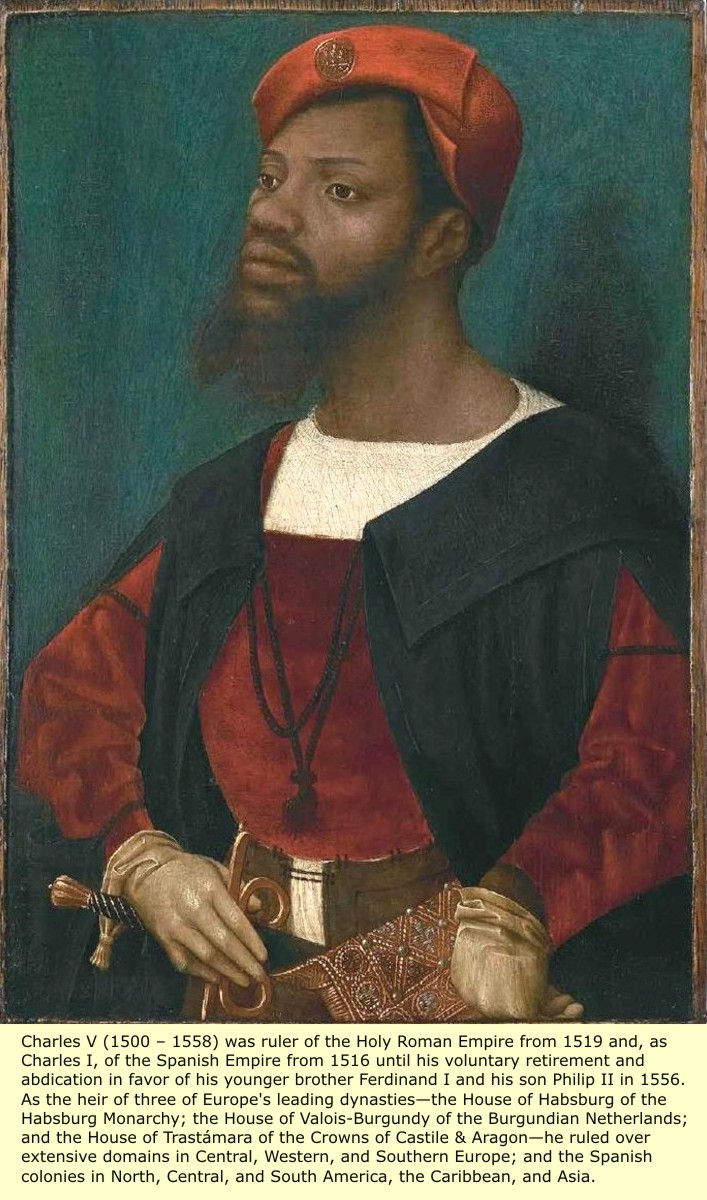
Please note: This site is an on-going expose' of the lies and falsifications of the Albino peoples history. Accordingly new pages like this one will contain the most recently acquired information, which may or may not be updated on older pages. Likewise, new information on future pages may not be undated on this page. Therefore the best procedure when looking for particular information is to use the search feature at the top of our main menu pages.
Background: In the beginning, as Humans started to leave Africa, included with the second (OOA) group were the Albinos of Caucasian phenotype Africans (Horn Africans, Dravidians (Indians) who were probably motivated by a quest for relief from the heat and burning Sunshine of southern Africa - and relief from the torment heaped upon them by normal Africans. Even today, superstitious Blacks of southern Africa; maim and mutilate Albinos in the ignorant belief that their body parts process magical properties, which they use in rituals. After they crossed the Arabian Peninsula and entered what is now India, the decided to head north and eventually ended up in Central Asia.
There they found a low sunlight intensity environment to their liking, and there they stayed, and flourished!
Then, at about 1,500 B.C. the Central Asian Albinos decided to start
leaving their low sunlight intensity environment, and return to India
as invading Aryans. Soon after, they headed WEST toward Europe. It can
only be guessed at, but perhaps after Millennia in Central Asia, the
Albinos forgot that they were Albinos, and what devastating effect
strong Sunlight could have on them.
For after their conquest of Europe in
the late medieval "Race Wars": Historically camouflaged as Civil Wars
in Britain, and the supposedly Religious "Thirty Years Wars" on the
continent. Note there really was a religious component to the "Thirty
Years Wars": That being the original Black Europeans (Catholics) verses
insurgent original Central Asian Albinos (Germanics & Slav's) under
the banner of their newly created "PROTEST" or "Protestant" Religions.
i.e. Anglican, Episcopalian, Presbyterian, Methodist, Lutheran,
Baptist, Amish, Evangelicalism, Pentecostalism, Quakers, Seventh-Day
Adventism, et al. After the conquest, the Catholic Church was also
usurped, but the Slav's in the East (like the Rus (Russians), chose not
to completely overhaul the Eastern Orthodox branch that they took from
the Byzantines. As a result, their Holy icons still have "Dark" Skin.
The later arriving Turks took over the Black Arabs newly created
religion of Islam. After their conquest of Europe, the Albinos went on
to conquer the entire WORLD, and each place they settled brought them
the SAME problems: SUNBURN and SKIN CANCER. Because they don't belong
in those places, their one and ONLY home is Central Asia!
_______________________________________________________________________________________________________
Feudalism = Slavery
Feudalism was a combination of legal and military customs in medieval Europe that flourished between the 9th and 15th centuries. Broadly defined, it was a way of structuring society around relationships derived from the holding of land in exchange for service or labor.
A fief was the central element of feudalism and consisted of heritable property or rights granted by an overlord to a vassal who held it in fealty (or "in fee") in return for a form of feudal allegiance and service, usually given by the personal ceremonies of homage and fealty. The fees were often lands or revenue-producing real property held in feudal land tenure: these are typically known as fiefs or fiefdoms. However, not only land but anything of value could be held in fee, including governmental office, rights of exploitation such as hunting or fishing, monopolies in trade, and tax farms.
A peasant is a member of a traditional class of farmers, either laborers or owners of small farms, especially in the Middle Ages under feudalism, or more generally, in any pre-industrial society. In Europe, peasants were divided into three classes according to their personal status: slave, serf, and free tenant. Peasants either hold title to land in fee simple, or hold land by any of several forms of land tenure, among them socage, quit-rent, leasehold, and copyhold. Serfdom is the status of many peasants under feudalism, specifically relating to manorialism. It was a condition of bondage, which developed primarily during the High Middle Ages in Europe and lasted in some countries until the mid-19th century.
Serfs who occupied a plot of land were required to work for the lord of the manor who owned that land, and in return were entitled to protection, justice and the right to exploit certain fields within the manor to maintain their own subsistence. Serfs were often required not only to work on the lord's fields, but also his mines, forests and roads. The manor formed the basic unit of feudal society, and the lord of the manor and his serfs were bound legally, economically, and socially. Serfs formed the lowest social class of feudal society - in reality there was little difference between a Serf and a Slave.
_______________________________________________________________________________________________________
The Black Spanish monarch at the time of Europe's discovery of the
Americas was Ferdinand II (1452–1516), he was King of Sicily from 1468
and King of Aragon from 1479 until his death. As a consequence of his
marriage to Isabella I, he was also King of Castile jure uxoris as
Ferdinand V from 1474 until her death in 1504. He was recognized as
regent of Castile for his daughter and heir, Joanna, from 1508 until
his own death. In 1504, after a war with France, he became King of
Naples as Ferdinand III, reuniting Naples with Sicily permanently and
for the first time since 1458. In 1512, he became King of Navarre by
conquest.
AND LATER:
Holy Roman Emperor Maximilian I (1459 – 1519), the son of Frederick
III, Holy Roman Emperor, and Eleanor of Portugal, he was also King of
the Romans (also known as King of the Germans) from 1486 and Holy Roman
Emperor from 1508 until his death, though he was never in fact crowned
by the Pope, (the journey to Rome always being too risky). He had ruled
jointly with his father for the last ten years of his father's reign,
from c. 1483. He expanded the influence of the House of Habsburg
through war and his marriage in 1477 to Mary of Burgundy, the heiress
to the Duchy of Burgundy, but he also lost the Austrian territories in
today's Switzerland to the Swiss Confederacy. Through marriage of
his son Philip the Handsome to eventual queen Joanna of Castile in
1498, Maximilian helped to establish the Habsburg dynasty in Spain
which allowed his grandson Charles to hold the thrones of both Castile
and Aragon. Since his father Philip died in 1506, Charles succeeded
Maximilian as Holy Roman Emperor in 1519, and thus ruled both the Holy
Roman Empire and the Spanish Empire simultaneously.
King Ferdinand is best known for he and Isabella sponsoring the
first voyage of Christopher Columbus in 1492. That year he also fought
the final war with Granada which expunged the last Islamic state on
Iberian soil (expulsion of the Moors), thus bringing to a close the
centuries-long Reconquista. At his death he was succeeded by Joanna,
who co-ruled with her son, Charles V, over all the Iberian kingdoms
except Portugal.
Charles V (1500–1558), also known as Charles I of Spain was Duke of Burgundy and ruler of the Netherlands from 1506, ruler of the Spanish Empire from 1516 and Holy Roman Emperor from 1519, until he voluntarily stepped down from these and other positions by a series of abdications between 1554 and 1556. Through inheritance, he brought together under his rule extensive territories in central, western, and southern Europe, and the Spanish colonies in the Americas and Asia. As a result, his domains spanned nearly four million square kilometers, and were the first to be described as "the Empire on which the sun never sets".
 |
Charles was the heir of three of Europe's leading dynasties: the
Houses of Habsburg, Valois-Burgundy and Trastámara. From his own
dynasty, the Habsburgs, he inherited Austria and other lands in central
Europe. He was also elected to succeed his Habsburg grandfather,
Maximilian I as Holy Roman Emperor, a title held by the Habsburgs since
1440. He inherited the Burgundian Netherlands and the Franche-Comté as
heir of the House of Valois-Burgundy. From the Spanish House of
Trastámara, he inherited the crowns of Castile, which was in the
process of developing a nascent empire in the Americas and Asia, and
Aragon. The latter included a Mediterranean empire that extended to
Southern Italy. Charles was the first king to rule Castile and Aragon
simultaneously in his own right, and, as a result, is sometimes
referred to as the first King of Spain. The personal union, under
Charles, of the Holy Roman Empire with the Spanish empire resulted in
the closest Europe would come to a universal monarchy in the
post-classical era.
Fearing that his vast inheritance would lead to the realization of a
universal monarchy and that he was trying to create a European
hegemony, Charles was the object of hostility from many enemies. His
reign was dominated by war, and particularly by three major
simultaneous conflicts: the Habsburg-Valois Wars with France, the
struggle to halt the Ottoman advance, and the Protestant Reformation
resulting in conflict with the German princes.
As we know, Christopher Columbus stumbled across the Americas
in 1492: what many don't know is that Columbus, or Cristóbal Colón (to
give him his proper spanish name), was a slave trader by trade. He had
cut his nautical teeth sailing under a Portuguese flag engaged in the
african slave trade a dozen years before heading to the Americas in
1492.
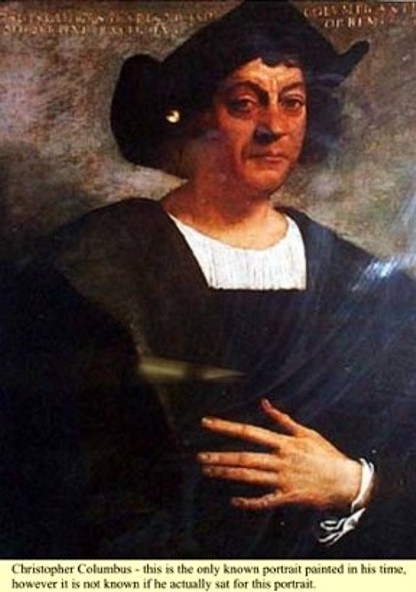 |
BACKGROUND ON SPANISH DEMOGRAPHICS:
A
perfunctory glance at a map will show that Spain was and is the
western-most easy entry point to Europe from Africa. And Africans have
crossed over to Europe through the narrow Gibraltar Strait since the
first migrations out of Africa. Thus regardless of Albino media
characterization of Spain, it is a racially and ethnically diverse
country. In the CIA Factbook they don't even try to break down the
demographics of Spain into the normal racial groups: Quote - Spain =
composite of Mediterranean and Nordic types
______________________________________________________________________________________________________
From Wiki: Spanish Ethnic groups
Definition of
ethnicity or nationality in Spain is fraught politically. The term
"Spanish people" (pueblo español) is defined in the 1978 constitution
as the political sovereign, i.e. the citizens of the Kingdom of Spain.
The same constitution in its preamble speaks of "peoples and
nationalities of Spain" (pueblos y nacionalidades de España) and their
respective cultures, traditions, languages and institutions. The
formerly nomadic Gitanos and Mercheros are distinctly marked by
endogamy and discrimination but they are dispersed through the country.
The native Canarians are the descendants of the population of the
Canary Islands prior to Spanish colonization in the 15th century. Also
included are many Spaniard citizens who are descendents of people from
Spain's former colonies, mostly from Equatorial Guinea, Argentina,
Dominican Republic, Ecuador, Peru, Colombia, Morocco and the
Philippines. There is also a sizable number of Spaniards of Eastern
European, Maghrebian, Sub Saharan-African, Asian and Middle Eastern
descent.
Native-born Spanish citizens of all ethnic groups make up 86% of the
total population, and 14% are immigrants. Among the immigrants, around
57% of them come from Spain's former colonies in Latin America
(including those from Cuba, Argentina, Ecuador, Puerto Rico, Chile and
Uruguay), Africa and Asia Philippines. The rest are mostly Eastern
European (especially Romanians, Bulgarians, Russians, Serbians,
Croatians, Bosnians, Ukrainians and Albanians), North and West Africans
(notably Moroccans, Algerians, Senegalese, Guineans, Nigerians and
Cameroonians), Middle Eastern peoples including the Lebanese and Syrian
communities, Indians, Pakistanis and Chinese, as well as a sizable
number of citizens from the European Union, as of 2007 mostly
Romanians, Bulgarians, British, Portuguese, Polish (central Europe),
and Germans.
______________________________________________________________________________________________________
All of the above is to frame the fact that the Spain of the 1500s
was a very reluctant Slaver. Not only was the Monarchy and Nobility in
part Black and Mulattoes, but they had just defeated the honored Moors
of North Africa, who had ruled and uplifted Spain for hundreds of
years. Thus the beginnings of slavery in the Americas under the Spanish
are murky, all we can say with certainty is that they were very
uncomfortable with it: not that they were against human exploitation,
no, they appear to be only against Black Slavery. Proof of that, is
that the Spanish imported to their "HUGE" holdings in the Americas:
which were at its greatest extent on the mainland of the Americas was:
North America south of Canada and west of the Mississippi River, plus
the Florida's, all of present-day Mexico and Central America, except
Panama.
Viceroyalty of Peru
After the Spanish conquest
of the Inca Empire in 1532, which opened up the vast territories of
South America to further conquests, the Spanish Crown established an
independent Viceroyalty of Peru (a Spanish colonial administrative
district), at Lima in 1540. The Viceroyalty of Peru originally
contained most of Spanish-ruled South America, governed from the
capital of Lima. The Viceroyalty of Peru was one of the two Spanish
Viceroyalties in the Americas from the sixteenth to the eighteenth
centuries.
However, the Spanish did not resist the Portuguese expansion of Brazil.
The Treaty of Tordesillas was rendered meaningless between 1580 and
1640 while Spain controlled Portugal. The creation of Viceroyalties of
New Granada and Rio de la Plata (at the expense of Peru's territory)
reduced the importance of Lima and shifted the lucrative Andean trade
to Buenos Aires ( Argentina), while the fall of mining and textile
production accelerated the progressive decay of the Viceroyalty of
Peru. Eventually, the viceroyalty would dissolve, as with much of the
Spanish empire, when challenged by national independence movements at
the beginning of the nineteenth century. These movements led to the
formation of the modern-day countries of Peru, Chile, Colombia, Panama,
Ecuador, Bolivia, Paraguay, Uruguay, Argentina, Guyana and Trinidad and
Tobago in the territories that at one point or another had constituted
the Viceroyalty of Peru.
Viceroyalty of New Granada
The Viceroyalty of
New Granada was the name given on 27 May 1717 to the jurisdiction of
the Spanish Empire in northern South America, corresponding to modern
Colombia, Ecuador, Panama, and Venezuela. The territory corresponding
to Panama was incorporated later in 1739, and the provinces of
Venezuela were separated from the Viceroyalty and assigned to the
Captaincy General of Venezuela in 1777. In addition to these core
areas, the territory of the Viceroyalty of New Granada included Guyana,
southwestern Suriname, parts of northwestern Brazil, northern Peru,
Costa Rica and Nicaragua.
Thus contrary to Albino characterizations to explain away the millions of Blacks on the Americas mainland, exclusive of Brazil, the Spanish imported relatively FEW African Slaves! Out of the hugeness of the Spanish Empire on the American MAINLAND: a meager ~500,000 African Slaves were imported by the Spanish. Which was a little more than the number of African Slaves imported to English Canada and the thirteen English colonies comprising the United States: ~350,000 African Slaves. {The great majority of African Slaves went to the Caribbean: ~4.3 million and Brazil: ~3.1 million}. Numbers current as of March 2016.
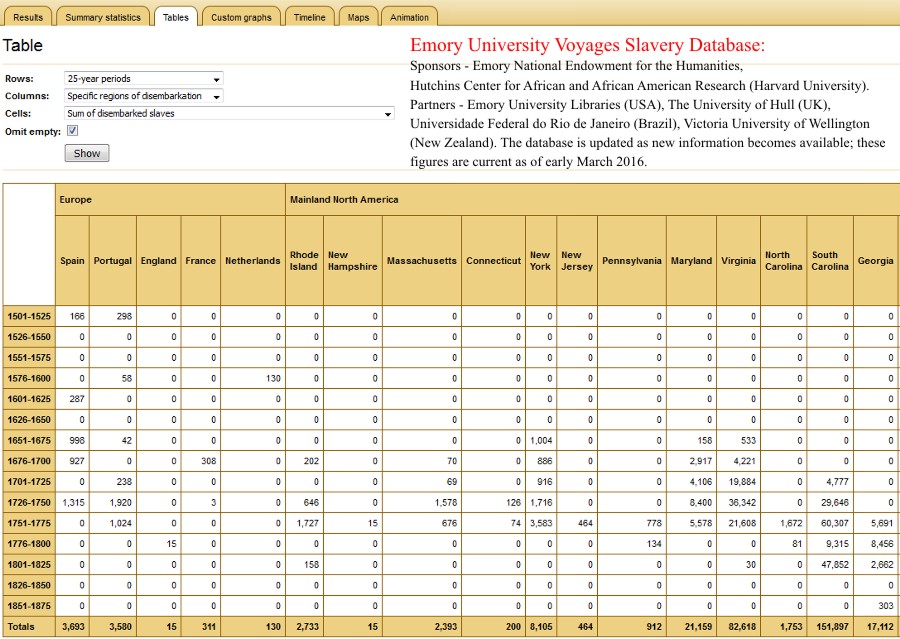 |
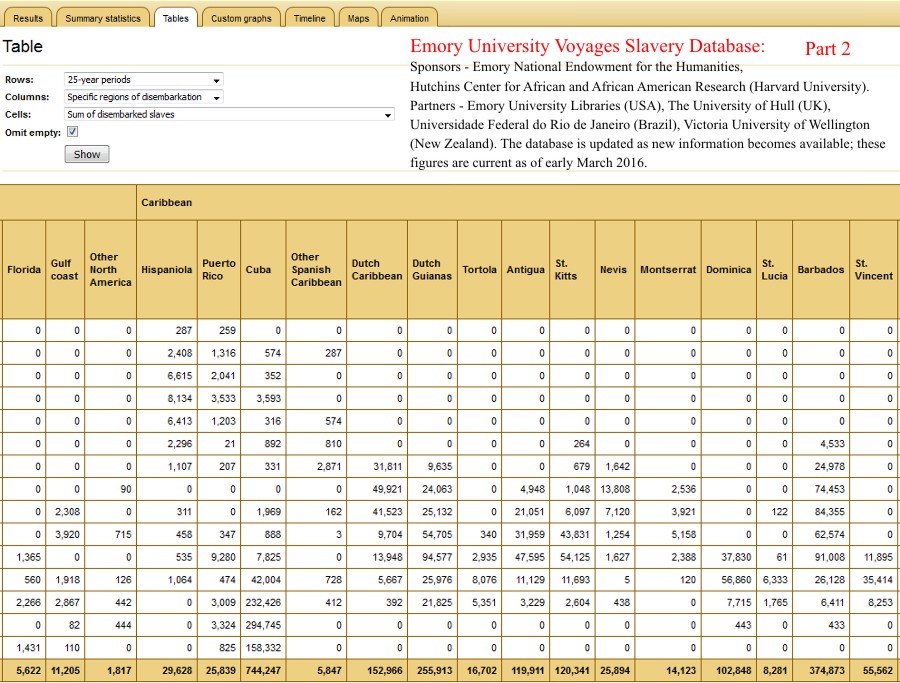 |
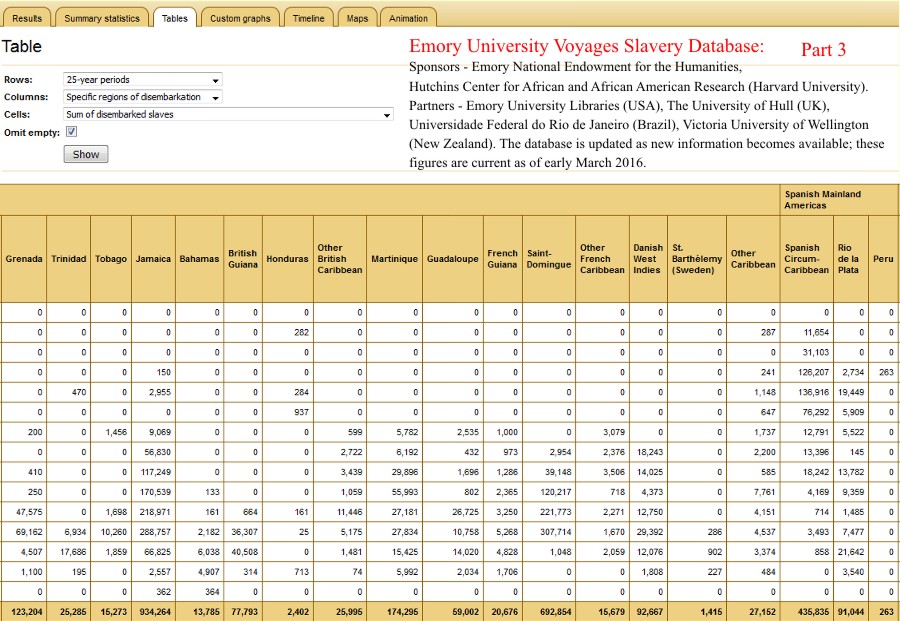 |
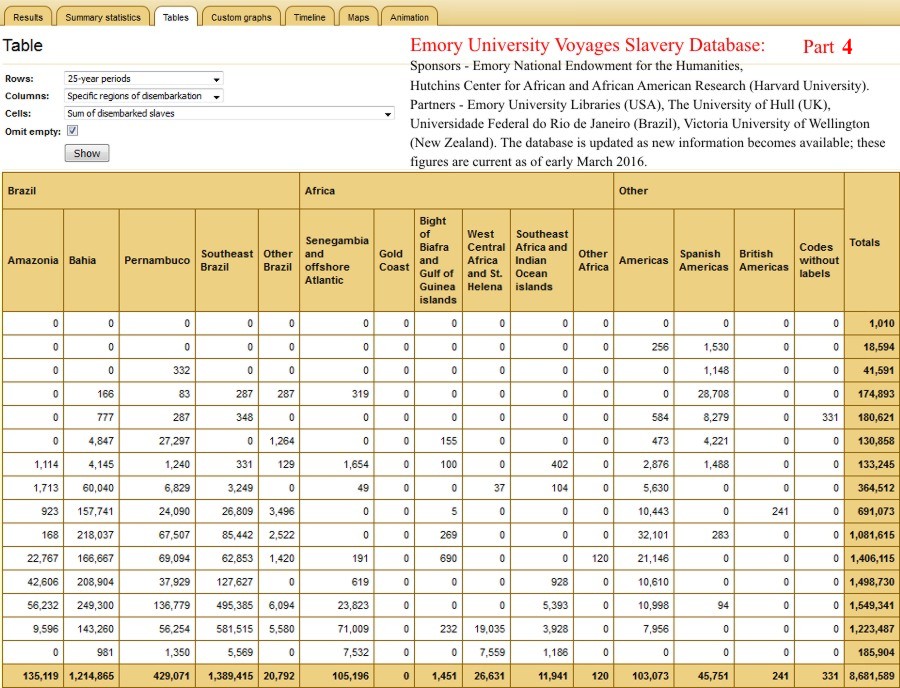 |
The Slave Voyages Consortium at Emory University has been updated for 2021.The latest version is Slave Voyages v2.2.13. A facsimile of the Table of number ofSlaves landed, and where they were disembarked, and the associated Map, is located here: Click>>>
|
 |
Columbus had laid the mental seeds for slavery during his first voyage in 1492, when he found how docile the natives were, the Slaver began to see them as potential Slaves and servants from early on. By the time he had reached Cuba, Columbus had begun to envision large settlements where the Spanish would supervise Indian laborers. He wrote that the Indians were ''fit to be ordered about and made to work, to sow and do everything else that may be needed . . . all that they are ordered to do they will do without opposition.'' He headed back to Spain with between six and nine natives. It is not known how many of the natives died on the long voyage. In Spain, Columbus was proclaimed a hero, and the planning began for a second expedition. Columbus knew that if he could not find the huge wealth of gold and silver that he had anticipated and promised, he need another scheme. That plan was to enslave the natives. He promised the king ''slaves, as many as they shall order.''
On the second voyage, begun in 1493, Columbus ordered natives
to be rounded up and returned to Spain to be sold. In February 1494,
several dozen Indian slaves arrived in Spain. Columbus expected them to
be sold and the money used to buy cattle and supplies to be shipped to
the New World. But King Ferdinand and Queen Isabella did not like the
plan. They ordered the trade stopped until the matter could be
discussed in detail. Still, Columbus continued to ship slaves to Spain.
About 1,600 were rounded up in 1495 on the island of Hispaniola. About
550 were put in chains for the voyage to Spain. The others were offered
to crew members as personal slaves. On the voyage back, nearly 200
Indians died and about half of those who survived were very sick.
Columbus also instituted a system of tribute. The Indians were required
to furnish a small quantity of gold every three months. Those who
failed to find enough gold - a difficult job on some islands - had
their hands cut off.
The Spanish king and queen were doubtlessly revolted by the brutal Albino, and remained undecided about slavery. After ordering the slave trade put on hold, they authorized the sale of slaves, then again changed their minds and said they wanted ''to consult with lawyers, theologians, and specialists in canon law to see whether they can be sold in good conscience.'' Finally, the royal couple ordered the Indian slaves in Spain freed and banned future sales.
__________________________________________________________________________________________
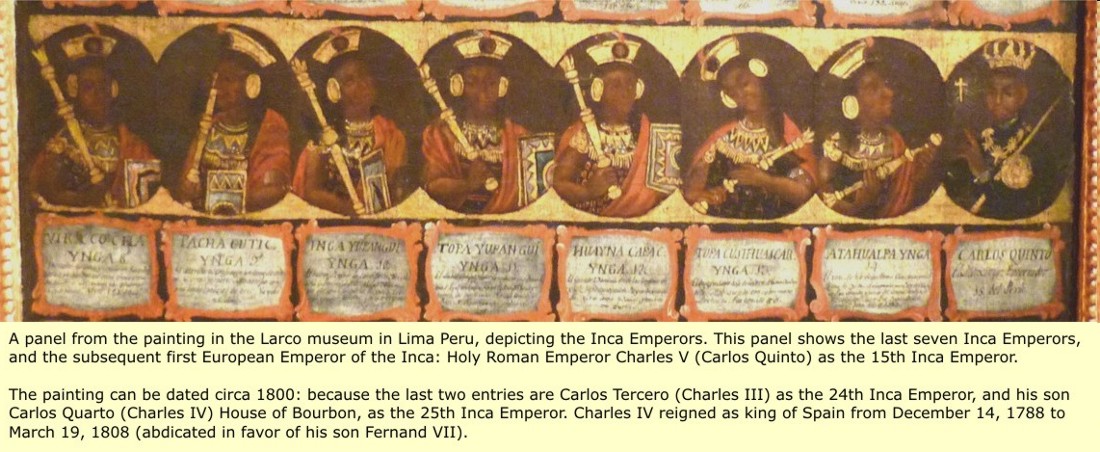 |
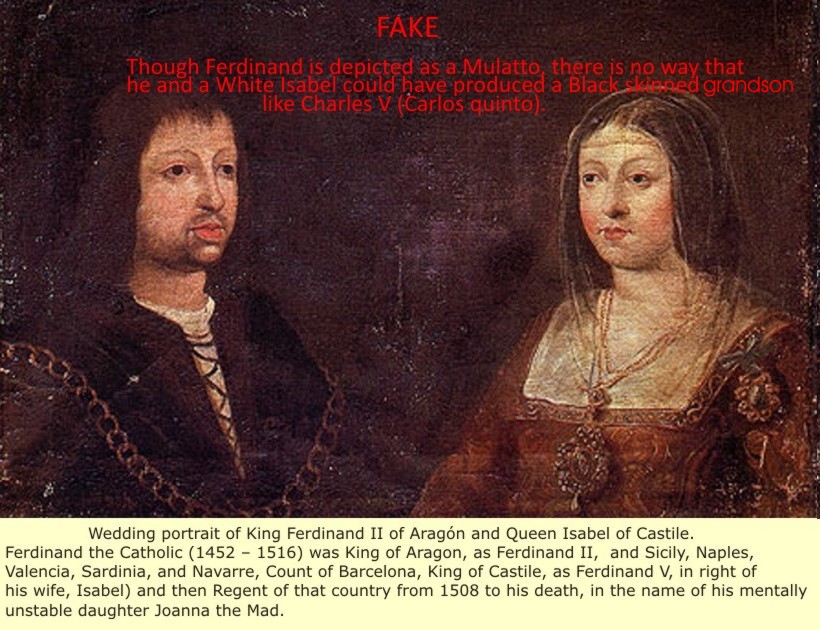 |
The papal bull Sublimus Dei of 1537, to
which Spain was committed, also officially banned slavery, but it was
rescinded a year after its promulgation (clearly Pope Paul III was a
Black man, perhaps one of the last Black Popes?), and just as clearly,
the fact that he had to rescind means that the Albinos were in the
process of taking power. Still, the Spanish were not good people, and
used other forms of coerced labor in their colonies instead: such as
the Indian Reductions method, the encomienda system, repartimiento, and
the mita.
Exhibits:
Sublimus Dei - Pope Paul III (Topic: the enslavement and evangelization of Indians)
Sublimis Deus [English: The sublime God (erroneously cited as Sublimus
Dei) is a papal bull promulgated by Pope Paul III on June 2, 1537,
which forbids the enslavement of the indigenous peoples of the Americas
(called Indians of the West and the South) and all other people. It
follows the decree issued by Charles I of Spain in 1530 in which the
King prohibited the enslavement of Indians.
The executing brief for the bull ("Pastorale Officium") was annulled
by Paul in 1537 at the request of the Spanish who had rescinded the
decree previously issued by Charles. The bull is cited at times as
evidence of a strong condemnation by the church of slavery in general,
but scholars point out that Paul sanctioned slavery elsewhere after the
issuing of Sublimis Deus.
To all faithful Christians to whom this writing may come,
health in Christ our Lord and the apostolic benediction. The sublime
God so loved the human race that He created man in such
wise that he might participate, not only in the good that other
creatures enjoy, but endowed him with capacity to attain to the
inaccessible and invisible Supreme Good and behold it face to face; and
since man, according to the testimony of the sacred scriptures, has
been created to enjoy eternal life and happiness, which none may obtain
save through faith in our Lord Jesus Christ, it is necessary that he
should possess the nature and faculties enabling him to receive that
faith; and that whoever is thus endowed should be capable of receiving
that same faith. Nor is it credible that any one should possess so
little understanding as to desire the faith and yet be destitute of the
most necessary faculty to enable him to receive it. Hence Christ, who
is the Truth itself, that has never failed and can never fail, said to
the preachers of the faith whom He chose for that office 'Go ye and
teach all nations.' He said all, without exception, for all are capable
of receiving the doctrines of the faith.
The enemy of the human race, who opposes all good deeds in order to
bring men to destruction, beholding and envying this, invented a means
never before heard of, by which he might hinder the preaching of God's
word of Salvation to the people: he inspired his satellites who, to
please him, have not hesitated to publish abroad that the Indians of
the West and the South, and other people of whom We have recent
knowledge should be treated as dumb brutes created for our service,
pretending that they are incapable of receiving the Catholic Faith.
We, who, though unworthy, exercise on earth the power of our Lord and seek with all our might to bring those sheep of His flock who are outside into the fold committed to our charge, consider, however, that the Indians are truly men and that they are not only capable of understanding the Catholic Faith but, according to our information, they desire exceedingly to receive it. Desiring to provide ample remedy for these evils, We define and declare by these Our letters, or by any translation thereof signed by any notary public and sealed with the seal of any ecclesiastical dignitary, to which the same credit shall be given as to the originals, that, notwithstanding whatever may have been or may be said to the contrary, the said Indians and all other people who may later be discovered by Christians, are by no means to be deprived of their liberty or the possession of their property, even though they be outside the faith of Jesus Christ; and that they may and should, freely and legitimately, enjoy their liberty and the possession of their property; nor should they be in any way enslaved; should the contrary happen, it shall be null and have no effect. By virtue of Our apostolic authority We define and declare by these present letters, or by any translation thereof signed by any notary public and sealed with the seal of any ecclesiastical dignitary, which shall thus command the same obedience as the originals, that the said Indians and other peoples should be converted to the faith of Jesus Christ by preaching the word of God and by the example of good and holy living. [Dated: May 29, 1537]
Indian reductions (Spanish: reducciones) were mission towns built
by Spanish Jesuit missionaries in Central and South America and
populated by the forcible relocation of indigenous populations. The
goal was to consolidate previously scattered populations to exert more
control over them including increasing baptisms and to improve the flow
of silver to the government in Spain. The local populations, who had
adapted to a way of life suitable to the many, minor microclimates
throughout the Andes, were uprooted and forced to assimilate. The new
towns were sometimes located in areas know to be prone to natural
disasters including flooding. The large population centers disrupted
family and kinship relationships. The indigenous people were exposed to
many new diseases like Smallpox, for which they had no immunity, and
many died as a result.
Encomienda, in colonial Spanish America, legal system by which the
Spanish crown attempted to define the status of the Indian population
in its American colonies. It was based upon the practice of exacting
tribute from Muslims and Jews during the Reconquista (“Reconquest”) of
Muslim Spain. Although the original intent of the encomienda was to
reduce the abuses of forced labor (repartimiento) employed shortly
after the discovery of the New World, in practice it became a form of
enslavement. As legally defined in 1503, an encomienda (from
encomendar, “to entrust”) consisted of a grant by the crown to a
conquistador, soldier, official, or others of a specified number of
Indians living in a particular area. The receiver of the grant, the
encomendero, could exact tribute from the Indians in gold, in kind, or
in labor and was required to protect them and instruct them in the
Christian faith. The encomienda did not include a grant of land, but in
practice the encomenderos gained control of the Indians’ lands and
failed to fulfil their obligations to the Indian population. The
crown’s attempts to end the severe abuses of the system with the Laws
of Burgos (1512–13) and the New Law of the Indies (1542) failed in the
face of colonial opposition and, in fact, a revised form of the
repartimiento system was revived after 1550. The encomienda was designed to meet the needs of the colonies’ early
mining economy. With the catastrophic decline in the Indian population
and the replacement of mining activities by agriculture, the system
lost its effectiveness and was gradually replaced by the hacienda
system of landed estates. The encomienda was not officially abolished,
however, until the late 18th century.
Repartimiento, ( Spanish: “partition,” “distribution”) also called
mita, or cuatequil, in colonial Spanish America, a system by which the
crown allowed certain colonists to recruit indigenous peoples for
forced labor. The repartimiento system, frequently called the mita in
Peru and the cuatequil (a Spanish-language corruption of Nahuatl
coatequitl or cohuatequitl) in New Spain (Mexico), was in operation as
early as 1499 and was given definite form about 1575. About 5 percent
of the indigenous peoples in a given district might be subject to labor
in mines and about 10 percent more for seasonal agricultural work. A
colonist who wanted a repartimiento had to apply to the viceroy or the
audiencia (provincial appeals court), stating that the supplemental
labor required on his plantation or ranch or in his mine would provide
the country with essential food and goods.
Legally, the work period was not to exceed two weeks (five in the mines), three or four times annually, and wages were to be paid. Those requirements were practically ignored, however, and, because the forced laborers were often brutally treated, the Spanish government modified the system in 1601 and 1609. Under the new arrangement, 25 percent of the indigenous peoples in a given district were required to work for the Spaniards, but they were free to choose their own employer and term of service. The new system remained legally in force down to the end of the colonial period (c. 1820). In practice, however, impressment of indigenous peoples under the earlier system continued in spite of additional royal prohibitive legislation in the 17th and 18th centuries.
1500–1699
1537: Pope Paul III forbids slavery of the
indigenous peoples of the Americas as well as of any other new
population that would be discovered, indicating their right to freedom
and property. However, only Catholic countries apply it, and state that
they cannot possibly enforce what happens in the distant colonies
(Sublimus Dei).
1542: Spain enacted the New Laws, abolishing slavery of Native
Americans in 1542. But replaced it with other systems of forced labor
such as repartimiento.
1569: An English court case involving Cartwright, who had brought a
slave from Russia, ruled that English law could not recognize slavery.
1588: The Third Statute of Lithuania abolishes slavery.
1595: A law is passed in Portugal banning the selling and buying of Chinese slaves.
1590: Toyotomi Hideyoshi bans slavery in Japan. However, it continued as a punishment for criminals.
19 February 1624: The King of Portugal forbids the enslavement of Chinese of either sex.
1683: the Spanish Crown legally abolish the slavery of indigenous Mapuche prisoners of war in Chile.
Wiki article
Thomas Thistlewood (16 March 1721 – 30 November 1786) was a British landowner and estate overseer who migrated to western Jamaica. He is remembered for his diary, which became an important historical document on slavery and history of Jamaica. Thomas Thistlewood was born in Tupholme, Lincolnshire, UK. In 1750 he left Britain and migrated to Jamaica, where he lived until his death in 1786. He became a small landowner and the overseer of the Egypt sugar plantation, which was located near the Savanna la Mar. His diary, "The Diary of Thomas Thistlewood" is a detailed record of his life and daily activities, providing a rare and detailed insight into plantation life, from agricultural techniques to slave-owner relations. With almost no restraints placed on their personal freedom, whites ruled their slaves with a degree of violence that left outside observers aghast. Thistlewood routinely punished his slaves with fierce floggings and other harsh punishments, some of them sickeningly ingenious. One of his favorites was "Derby's dose," in which a slave was forced to defecate into the offending slave's mouth, which was then wired shut for four or five hours.
Richard Newton (1777–1798) was an English caricaturist.
This short-lived but brilliant 18th-century caricaturist published his first caricature at thirteen. His work included definitive caricatures expressing the English prejudice of the Scots. He worked for radical publisher William Holland, producing powerful anti-slavery works among his output. This caricature of his is important in "Who" it depicts as the brutal Slave Master.
 |
Agostino Brunias (1730 – 1796) was a London-based Italian painter from Rome. Strongly associated with West Indian art, he left England at the height of his career to chronicle Dominica and the neighboring islands of the West Indies. Note the difference between what Albino historians depict in the colonial caribbean, and what Augostino Brunias depicts. To explain away these differences, the Albinos declare that his art was escapist and romantic.
The Americas were first peopled by Blacks from what appears to be many different locations around the world, circa 100,000 B.C. Then by Mongols who came across the Bering Straits, circa 12,000 B.C.Naturally Albinos do their best to confuse the issue, often by simply misidentifying people. See the Pre-historic America section.
|
 |
 |
 |
Some have described these Black Carib Indians as the offspring of Runaway African Slaves and Non-Black native Indians - even some Black institutions have stupidly accepted that nonsense, which is no surprise. As always when dealing with what the lying Albinos say, one must always think "Critically". i.e. The British outlawed the Slave trade in 1807, but did not outlaw Slavery until 1833. The painter of these paintings "Augustin Brunias" died in 1796: at the time he painted those people, if what the Albinos say was true: they and their still living parents, would have been subject to re-capture and a return to Slavery. They would certainly not have been allowed such easy movement and social intercourse, for fear their example would have fomented rebellion among Slaves. |
 |
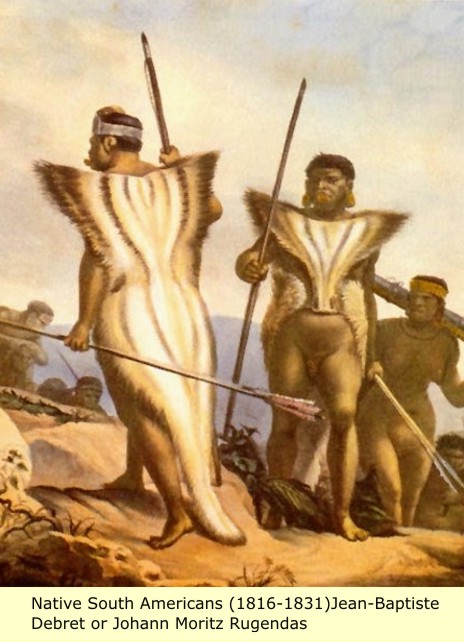 |
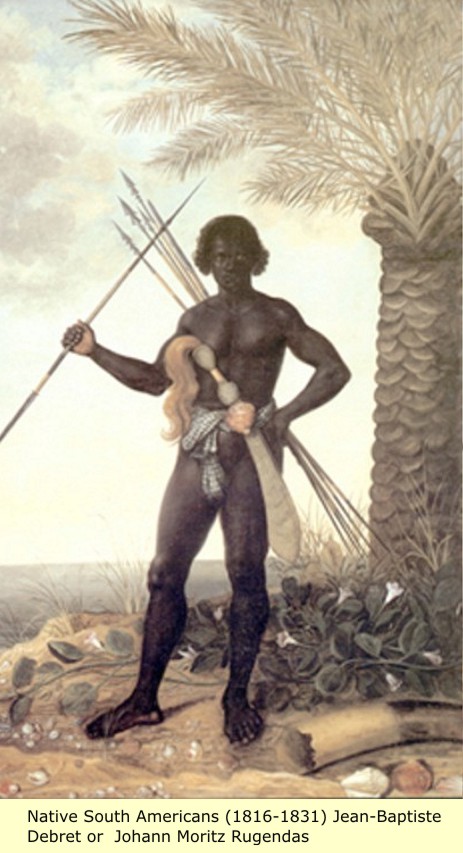 |
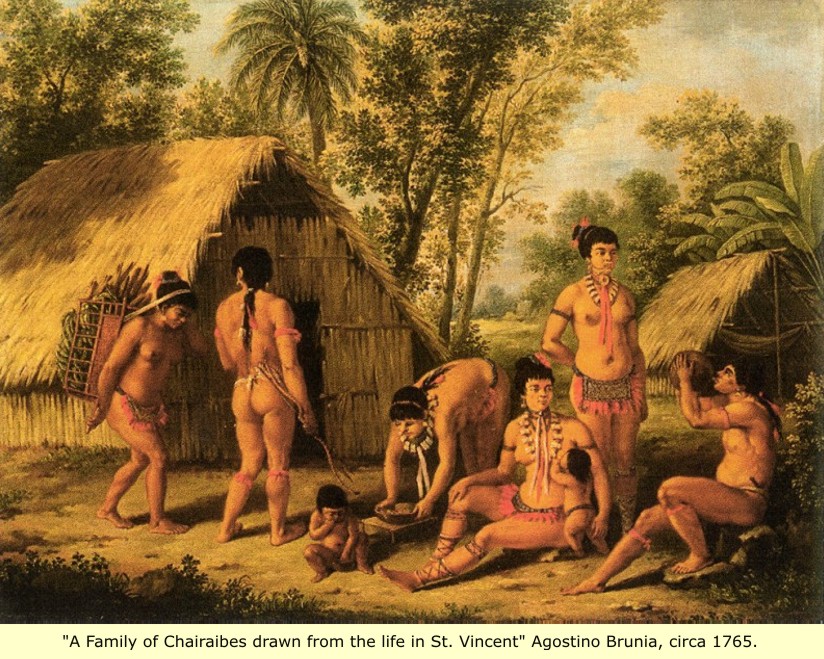 |
 |
 |
 |
|
|
Brown University is a private Ivy League research university in Providence, Rhode Island. It is the seventh-oldest institution of higher education in the United States, founded in 1764 as the College in the English Colony of Rhode Island and Providence Plantations. Which means it educates some of Americas "Wealthiest" students. We are wondering WHY they PURPOSELY confused the NATIVE AMERICAN Carib's on St. Vincent with the "Mixed" Maroons of Jamaica. (Of course it's just another Albino ploy to confuse Black history).
 |
 |
 |
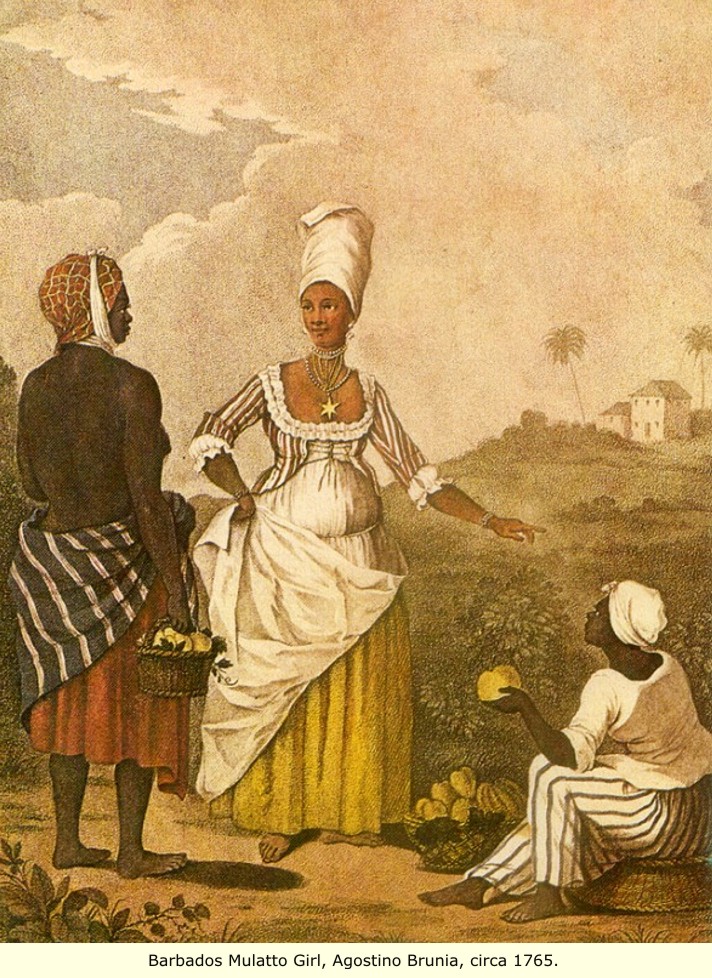 |
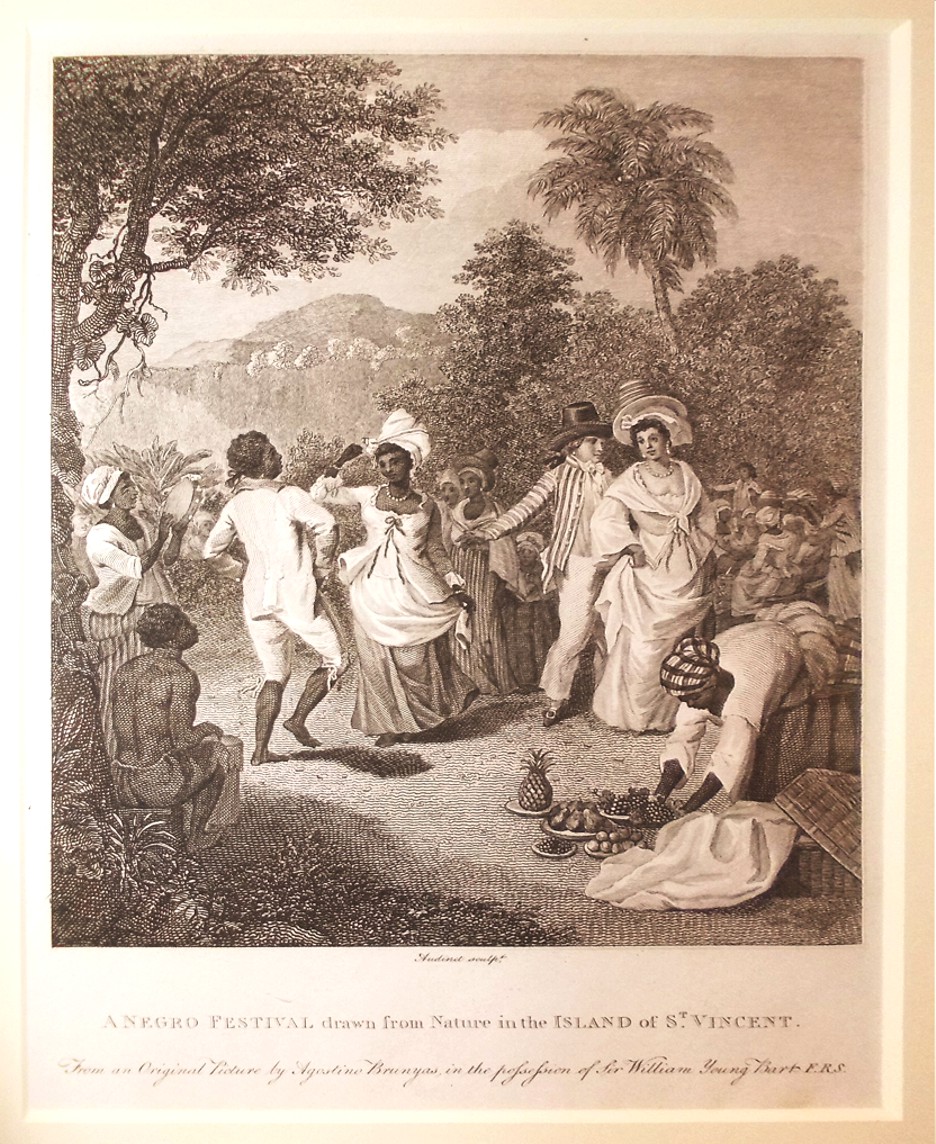 |
Click here for Jamaican History: courtesy the Jamaica government
On May 5, 1494 Christopher Columbus, the European explorer, who
sailed west to get to the East Indies and came upon the region now
called the West Indies, landed in Jamaica. This occurred on his second
voyage to the West Indies. Columbus had heard about Jamaica, then
called Xaymaca, from the Cubans who described it as “the land of
blessed gold”. Columbus was soon to find out that there was no gold in
Jamaica.
On arrival at St Ann’s Bay, Columbus found the Arawak Indians
inhabiting the island. Initially, Columbus thought these Indians were
hostile, as they attacked his men when they tried to land on the
island. As he was determined to annex the island in the name of the
king and queen of Spain, he was not deterred. Columbus also needed wood
and water and a chance to repair his vessels. He sailed down the coast
and docked at Discovery Bay. The Arawaks there were also hostile to the
Spaniards. Their attitudes changed however, when they were attacked by
a dog from one of the Spanish ships and Columbus’ cross-bow men. Some
of the Arawaks were killed and wounded in this attack. Columbus was
then able to land and claim the island.
The Spaniards, when they came, tortured and killed the Arawaks to
get their land. They were so overworked and ill-treated that within a
short time they had all died. The process was aided by the introduction
of European diseases to which the Arawaks had little or no resistance.
The island remained poor under Spanish rule as few Spaniards settled
here. Jamaica served mainly as a supply base: food, men, arms and horse
were shipped here to help in conquering the American mainland. Fifteen
years later in 1509, after their first visit to the island, the first
Spanish colonists came here under the Spanish governor Juan de
Esquivel. They first settled in the St. Ann’s Bay area. The first town
was called New Seville or Sevilla la Nueva. Towns were little more than
settlements. The only town that was developed was Spanish Town, the old
capital of Jamaica, then called St. Jago de la Vega. It was the centre
of government and trade and had many churches and convents. The little
attention the colony received from Spain soon led to a major reason for
internal strife. This contributed to the weakening of the colony in the
last years of Spanish occupation. The governors were not getting proper
support from home and quarrels with church authorities undermined their
control. Frequent attacks by pirates also contributed to the colony’s
woes.
The English Attack
On May 10, 1655, Admiral
William Penn and General Robert Venables led a successful attack on
Jamaica. The Spaniards surrendered to the English, freed their slaves
and then fled to Cuba. It was this set of freed slaves and their descendants see JNL material below - who became known as the Maroons.
The early period of English settlement in Jamaica, drew much
attention to the buccaneers based at Port Royal. Buccaneering had begun
on the islands of Tortuga and Hispaniola. They were a wild, rough and
ruthless set of sea rovers. They took their loot of gold, silver and
jewels to Port Royal. Port Royal prior to this time was an
insignificant town in Jamaica. Under the buccaneers’ leadership the
town, within a decade and a half, grew to become known as one of the
“wealthiest and wickedest city in the world”.
__________________________________________________________________________________________________________
Wiki:
The Jamaican Maroons are descendants of
Africans who fought and escaped from slavery and established free
communities in the mountainous interior of Jamaica during the era of
slavery. African slaves imported during the Spanish period may have
provided the first runaways. Slavery continued after the English took
over Jamaica. Africans in Jamaica continually fought and revolted. The
revolts had the effect of disrupting the sugar economy in Jamaica and
making it less profitable. The revolts simmered down only after the
English government promised to free the slaves if they stopped
revolting.
It is with this English Wiki of the
Maroons that we get to the main point of this paper: it is typical
Albino lie that Black = African Slave.
As we have seen from
Jamaican history, the Maroons did not escape, supposedly the Spanish
freed them. But did they really, and who were the so-called Maroons
really?
__________________________________________________________________________________________________________
Well, according to Africana.com, the former Black history
site of Harvard Professors Henry Louis Gates Jr. and Kwame Anthony
Appiah, (since sold to conglomerate Time Warner - more on that below):
Quote: The Spanish began importing black slaves shortly after King Ferdinand authorized the governor of Hispaniola (island encompassing present-day Haiti and Dominican Republic) to import Christian blacks (ladinos) from Spain in 1501. The first black slaves brought to Jamaica did not come directly from Africa but were either Africans, or the descendants of Africans, who had been enslaved for a time in Spain. In 1518 King Charles I of Spain (Ferdinand's successor) signed a four-year contract, or asiento, allowing an annual supply of 4,000 African slaves to enter Hispaniola, Cuba, Jamaica, and Puerto Rico. Slaves then came directly from Africa. By 1611 Jamaica had a population of 558 black slaves, 107 free blacks, and between 1,200 and 1,400 Spaniards.
As can be seen in a search of the Emory University database their numbers are quite different. This is quite normal, as new material is constantly being found and used to update our knowledge. Regardless, the point is confirmed that the Spanish imported few Slaves.
Ladino people are a mix of mestizo or hispanicized peoples in Latin America, principally in Central America. The demonym Ladino is Spanish, deriving from "latino" and came into use during the colonial era to refer to the Spanish-speaking population that did not belong to the colonial elite of Peninsulares or Criollos, nor to the indigenous peoples. A peninsular was a Spanish-born Spaniard residing in the New World or the Spanish East Indies. The word peninsular makes reference to Peninsular Spain situated on much of the Iberian Peninsula. The Criollo were a social class in the hierarchy of the overseas colonies established by Spain in the 16th century, especially in Hispanic America, comprising the locally born people of confirmed European (primarily Spanish) ancestry. The Criollo class ranked below that of the Iberian Peninsulares. Criollos were higher status/rank than all other castes — people of mixed descent, Amerindians, and enslaved Africans.
 |
_________________________________________________________________________________________________________________
In Iberia (Spain), as a result of the Moor conquest, many of the ousted White nobles took refuge in the unconquered north Asturian highlands. From there they aimed to reconquer their lands from the Moors: this war of reconquest is known as the Reconquista. It began in about 900 A.D. when a small Christian enclave of Visigoths in northwestern Spain, named Asturias; initiated conflicts between Christians and Muslims. Soon after, Christian states based in the north and west slowly; in fits and starts, began a process of expansion and reconquest of Iberia over the next several hundred years. The end for the Moors came on January 2, 1492: the leader of the last Moorish City "Granada" (located in southern Spain) surrendered to armies of a recently united Christian Spain (after the marriage of Ferdinand II of Aragon and Isabella I of Castile). This ended the 800 year reign of the Moors in Iberia. This victory was accompanied by the forced conversion of Spanish Muslims (Moriscos) and Khazar Jews. As a result of the Inquisition, thousands of Khazar Jews fled or were deported to the Maghrib, where many gained influence in government and commerce.
Without much difficulty, Christian Spain imposed its influence on the Maghrib coast by constructing fortified outposts (presidios) and collecting tribute during the fifteenth and early sixteenth centuries. On or near the Algerian coast, Spain took control of Mers el Kebir in 1505, Oran in 1509, and Tlemcen, Mostaganem, and Ténès, all west of Algiers, in 1510. In the same year, the merchants of Algiers handed over one of the rocky islets in their harbor, where the Spaniards built a fort. The presidios in North Africa turned out to be a costly and largely ineffective military endeavor, that did not guarantee access for Spain's merchant fleet. Indeed, most trade seemed to be transacted in the numerous free ports. Moreover, from the sixteenth to the eighteenth century, sailing superior ships and hammering out shrewd concessions, merchants from England, Portugal, Holland, France, and Italy, as well as Spain, dominated Mediterranean trade.
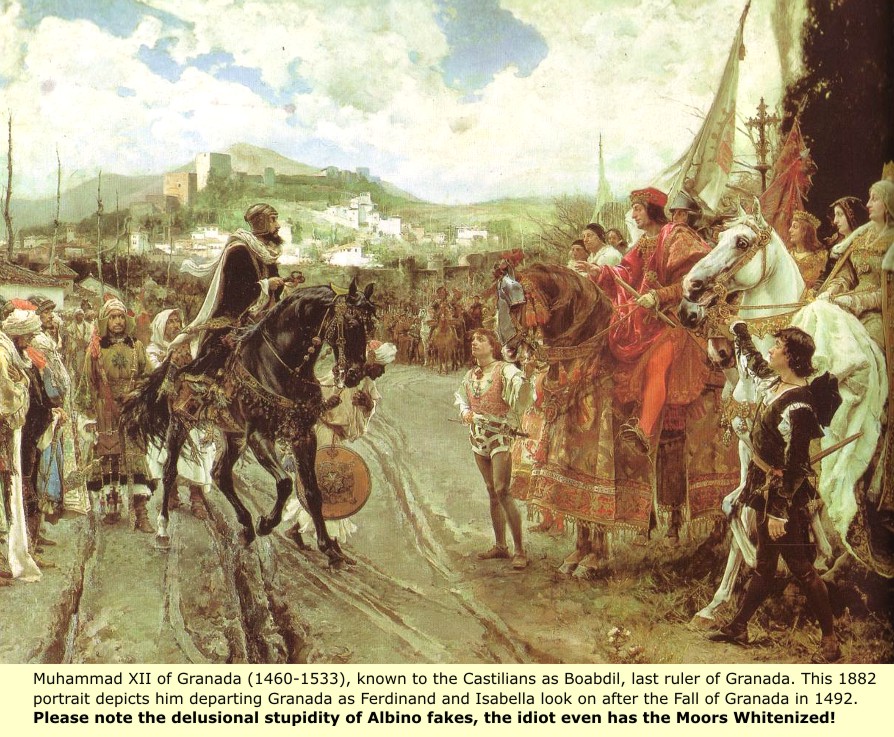 |
 |
_________________________________________________________________________________________________________________
Before going on with Jamaica history: please
note - The Jamaican governments history and Henry Louis Gates Jr.
history of Jamaica, both clearly indicate and unquestioning acceptance
of the Albino version of history, which we prove on a daily basis to be
lies. So critical judgment should be exercised when reading this short
version from the Gates Jamaican history site, which is being used
because it includes more interesting details.
http://www.hartford-hwp.com/archives/43/130.html
http://africana.com/tt/1122.htm
By Veront Satchell, Africana.com, 1999
Independent country in the Caribbean and a member of the British Commonwealth of Nations, located south of Cuba and west of Haiti in the Caribbean Sea. Jamaica is the third largest island of the Greater Antilles (island chain in the West Indies that encompasses the nations of Cuba, Haiti, Dominican Republic, and Puerto Rico).
Although Jamaica has a diverse population, Afro-Jamaicans constitute the overwhelming majority. The 1991 census recorded a total population of 2.3 million. Blacks accounted for 2.08 million, or 90.5 percent of the total population, while whites accounted for 5,200, or 0.2 percent. East Indians made up 1.3 percent and Chinese 0.3 percent. Other ethnic groups as well as small numbers of Syrians, Lebanese, and Jews made up 0.5 percent. People of mixed descent accounted for 7.3 percent of the population. Recognition of this diversity led the framers of Jamaica's constitution at independence, in 1962, to choose as the island's motto 'Out of Many, One People,' suggesting that despite racial and ethnic differences, all live united as one Jamaican people.
However, racism and color discrimination-the legacy of more than three centuries of slavery-persist to this day in Jamaica, although in a very subtle and suppressed way. Since slavery was abolished in 1834, blacks have achieved much upward social mobility, primarily through entrepreneurship and education. They seem to control political power, especially since Percival Patterson became prime minister in 1992, the first black man to hold that office. Economic power, however, continues to elude the black majority, and many issues concerning race have not been fully resolved in Jamaica.
EUROPEAN CONQUEST AND COLONIZATION
Archaeological finds suggest that the Native American Tainos were
the first to settle the island of Jamaica, which they called Xaymaca
(meaning 'land of springs' or 'land of wood and water'). Estimates for
the Taino population at the time of the Spanish arrival in the late
1400s vary widely, with the lowest estimates ranging from 6,000 to
9,000 and the highest from 60,000 to 100,000. Taino villages were
distributed throughout the island, with the majority situated near the
coastline and adjacent to rivers. The Tainos were a seafaring people
who relied on fishing to provide a large part of their diet. They also
were agriculturalists, cultivating cassava, maize, sweet potatoes, and
arrowroot. They traded with Native American communities living on
neighboring islands in the Greater Antilles. For administrative
purposes, the Tainos divided the island into provinces that were ruled
over by a cacique (chief) assisted by subchiefs.
Spanish Conquest
During his second voyage to the Americas, European explorer Christopher Columbus learned of Jamaica from the indigenous people on the island of Cuba. He set foot on the northern part of Jamaica, at present-day Saint Ann's Bay, on May 4, 1494. After defeating the Tainos' initial resistance, Columbus seized the island for Spain. Spain sent Juan de Esquivel to establish a settlement in 1509, beginning Spain's effective colonization of Jamaica. The Spanish established Sevilla la Nueva on the northern part of the island as their first administrative center but abandoned it in 1523 for Saint Jago de la Vega (now Spanish Town) in the south. Interest in Jamaica faded when it became obvious there was no gold, and the island became a backwater in the Spanish Empire. As late as the time of the English conquest in 1655, the island remained underdeveloped, poor, and sparsely populated. The Spanish lived just above subsistence level, developing a small-scale pig and cattle ranching economy. They also practiced small-scale agricultural cultivation for domestic consumption and for sale to the few Europe-bound vessels.
The Spanish colonists instituted a regime of forced labor of the Taino. Although indigenous peoples in the Spanish colonies were legally exempted from slavery by royal decree in 1542, the colonists were able to compel the Tainos to work for them under the systems of encomienda and repartimiento. Overwork in the mines and fields, combined with contact with European diseases, resulted in the annihilation of Jamaica's indigenous population by the mid-1600s.
The Spanish began importing black slaves shortly after King Ferdinand authorized the governor of Hispaniola (island encompassing present-day Haiti and Dominican Republic) to import Christian blacks (ladinos) from Spain in 1501. The first black slaves brought to Jamaica did not come directly from Africa but were either Africans, or the descendants of Africans, who had been enslaved for a time in Spain. In 1518 King Charles I of Spain (Ferdinand's successor) signed a four-year contract, or asiento, allowing an annual supply of 4,000 African slaves to enter Hispaniola, Cuba, Jamaica, and Puerto Rico. Slaves then came directly from Africa. By 1611 Jamaica had a population of 558 black slaves, 107 free blacks, and between 1,200 and 1,400 Spaniards.
English Conquest
On May 10, 1655, an English expedition, commanded by Admiral William Penn and General Robert Venables, landed at the present-day coastal town of Passage Fort, in the southeastern parish of Saint Catherine. This expedition, which had failed to capture Hispaniola, proceeded to claim the island of Jamaica for England. At the time of the English conquest, the Spaniards were unable to effectively resist the invasion because only about 500 of them were armed with weapons. The English ordered the Spanish colonists to deliver all of their slaves and goods and leave the island. Some followed these orders, but a group led by Don Cristabal Arnaldo de Isasi remained and put up guerrilla resistance to the English. Isasi freed the slaves, many of whom retreated with the Spanish rebels into the hills. From there, the Spanish and the freed blacks who had joined them frequently raided and waged guerrilla warfare on English settlements. Isasi, finally overwhelmed by English forces, fled to Cuba for reinforcement. Some of the blacks who had fought with Isasi, recognizing that the Spanish case was lost, defected to the English. A black regiment fighting for the English, led by the former slave Juan de Bolas, proved a decisive factor in the final defeat of the Spanish, marked by Isasi's retreat in 1660.
Jamaica's English-appointed governor Edward D'Oyley compensated the black regiment by officially recognizing their freedom and granting them landholdings. Other formerly Spanish-owned slaves remained autonomous of the colonial administration, living in their own communities as maroons. Spain officially ceded the island to England under the Treaty of Madrid in 1670. The English established a representative system of government, giving white settlers the power to make their own laws through an elected House of Assembly, which acted as a legislative body. The Legislative Council, whose members were appointed by the governor, served an advisory function and took part in legislative debates. This system lasted until it was replaced in 1866 by the crown colony system of government, which stripped the island elite of most of its political power.
THE SLAVE TRADE AND PLANTATION ECONOMY
The English encouraged permanent settlement through generous land grants. In 1664 Sir Thomas Modyford, a sugar plantation and slave owner in Barbados (a Caribbean island of the Lesser Antilles chain), was appointed governor of Jamaica. He brought 1,000 English settlers and black slaves with him from Barbados. Modyford immediately encouraged plantation agriculture, especially the cultivation of cacao and sugarcane. By the early 1700s sugar estates worked by black slaves were established throughout the island, and sugar and its by-products dominated the economy. Other economic activities, including livestock rearing and the cultivation of coffee and pimento (allspice), developed as well.
With the establishment of the plantation system, the slave trade grew. Slaves of both genders and every age were found in all facets of the island's economy, in both rural and urban areas. They were laborers on plantations, domestic servants, and skilled artisans (tradesmen, technicians, and itinerant traders). The wealth created in Jamaica by the labor of black slaves has been estimated at £18,000,000, more than half of the estimated total of £30,000,000 for the entire British West Indies. It has been postulated that the profit generated by the 'triangular trade' (involving sugar and tropical produce from the British Caribbean colonies, the trade in manufactured goods for slaves in Africa, and the trade of slaves in the British Caribbean) financed the Industrial Revolution in Britain.
More than 1 million slaves are estimated to have been transported directly from Africa to Jamaica during the period of slavery; of these, 200,000 were reexported to other places in the Americas. During the 17th and 18th centuries, the Akan, Ga, and Adangbe from the northwestern coastal region known as the Gold Coast (around modern Ghana) dominated the slave trade to the island. Not until 1776 did slaves imported from other parts of Africa-Igbos from the Bight of Biafra (southern modern Nigeria) and Kongos from Central Africa-outnumber slaves from the Gold Coast. But slaves from these regions represented 46 percent of the total number of slaves. The demand for slaves required about 10,000 to be imported annually. Thus slaves born in Africa far outnumbered those who were born in Jamaica; on average they constituted more than 80 percent of the slave population until Britain abolished the slave trade in 1807. When Britain abolished the institution of slavery in 1834, Jamaica had a population of more than 311,000 slaves and only about 16,700 whites. [End quote]
-------------------------------------------------------------------------------------------------------------------------
From review of: Whence the ("Black Irish") of Jamaica?
by JOSEPH J. WILLIAMS, S.J., Ph.D., Litt. D., F.R.S.A., F.R.G.S., F.A.G.S. (New York: Dial Press, 1932.)
Five years residence in Jamaica impressed Father Williams with the fact that
the Jamaica Negroes were unlike all other Negro types that he had seen. Particularly
among those of Gold Coast origin he found claims and remnants of
Judaism. His resultant studies led to his Hebrewisms of West Africa (1930).
But another outstanding fact was the large number of Negroes with pure Irish
names. These negroes could not be explained as descendants of slaves owned by
early Irish colonists, for no such names appear among the land-owners in the survey
of 1670. So Father Williams turns to English records of the crushing of the Irish,
by Cromwell, with consequent deportations of large numbers of Irish as bondmen
or bondmaids to the West Indies-especially Barbados, where such names as
Cavan, Collins, Connolly, Donovan, Duffey, Dunn, Grogan, Kelly, McCann,
McSwiney, McDermott, Moriarity, O’Brien, O’Neal, O’Halloran, Walsh, abound
in the old cemeteries. Father Williams gives pictures of Jamaica negro children
named Collins, Walsh, McKeon, McDermott, Burke, Mackey, McCormack,
Kennedy. His bibliography on the deportations and barbarities includes 175
sources. Beyond this his 100-page monograph does not go.
--------------------------------------------------------------------------------------------------------------------------------
JAMAICA - ARRIVAL 1600S
The Irish arrived in Jamaica over 350 years ago in the mid-1600s at the time of British Lord Protector Oliver Cromwell's capture of Jamaica. When British Admirals Penn and Venables failed in their expedition to take Santo Domingo from the Spanish, they turned their attention to Jamaica, not wanting to return to Cromwell empty-handed. With reinforcements from British-held Barbados (many of whom were Irish) they made quick work of dispatching the weak Spanish defence and soon realized that they needed workers to support their new prize. They looked eastward to islands already under British control, Barbados, St. Lucia, St. Kitts and Montserrat, and imported young, mainly male, bonded servants, many of whom were Irish.
In 1641 Ireland's population stood close to 1.5 million. Following a 1648 battle in Ireland known as the "Siege of Drogheda" in which Irish rebels were brutally subdued, Oliver's son, Henry, was named Major General in command of English forces in Ireland. Under his jurisdiction, thousands of Irish men and women were shipped to the West Indies to provide a source of indentured labour. Between 1648 and 1655, over 12,000 political prisoners alone were sent to Barbados. This was the first set to come involuntarily as prior to that the Irish had willingly chosen to subject themselves to terms of indenture for the chance to start a new life in the New World upon completion of their contracts.
By 1652, Ireland's population had dwindled to a little over half a million famine, rebellion and forced deportation, all factors.Throughout the early years of the 1650s there was a push to send young men and women to the colonies in what the English believed was a "measure beneficial to the people removed, who might thus be made English and Christians; and a great benefit to the West India sugar planters, who desired the men and boys for their bondsmen, and the women and Irish girls in a country where they had only Maroon women and Negresses to solace them" (Williams, 1932, pp. 10-11). The 13-year war from 1641-1654 had left behind large numbers of widows and deserted wives. In addition, many Irish men, their properties confiscated by Cromwell had no means of making a living. By 1655 some 6,400 Irish had been shipped off when in March all orders to capture "all wanderers, men and women and other such Irish in their possession" were revoked (Williams, pp. 12-13).
FIRST STOP
The first stop for many of the Irish, Catholic and non-Catholic, was Barbados where they worked from 6 a.m. to 6 p.m. with a two-hour lunch break, under the command of an overseer. Shirt and drawers were their only clothes and their homes, cabins made of sticks and plantain leaves (Williams, 1932, p. 42). Following the 1655 British conquest of Jamaica, Irish labourers were largely sent from Barbados as well as Ireland to get the island up and running under British control. Within a decade, when many Irish had served their terms or indenture, their names begin to appear among the lists of Jamaican planters and settlers (Williams, p. 53).
LAST SHIPMENTS 1800S
It is estimated that somewhere between 30,000 and 80,000 Irish were shipped from Ireland. One of the last shipments was made in 1841 from Limerick aboard the Robert Kerr. The Gleaner noted of these arrivals: "They landed in Kingston wearing their best clothes and temperance medals," meaning they did not drink alcohol (as quoted in Mullally, 2003, part 2, pg. 1). The Gleaner also noted of another set of arrivals in 1842: "The Irish are repeatedly intoxicated, drink excessively, are seen emerging from grog shops very dissolute and abandoned and are of very intemperate habits" (as quoted in Mullally, 2003, part 3, p. 2). So the Irish gained a reputation for being something of a mixed blessing - saints and sinners.
However, other European immigrants did not seem to fare as well as the Irish in the tropical climate. In the mid-1830s, for example, when the government was particularly concerned about replacement labour for the newly-freed slaves on the sugar and coffee plantations, the over 1,000 Germans and close to 200 Portugese from Madeira, the Azores and Portugal notched a high mortality rate. The idea was to eventually create townships for the European immigrants in the island's highlands where the temperature was cooler and they would work as small farmers, labourers and artisans on coffee estates and cattle pens.
However, this would take time and in order to maintain pre-abolition levels of production, labour was needed in Jamaica's low-lands where the best land for sugar cultivation was located. Hence the implementation of bounties for European immigrants and the institution of ships like the Robert Kerr, known as "man-traps" and sub-agents who wandered into quiet Irish towns and attracted people with the promise for free passage, high wages and the hope of bettering their lives. The immigration of Europeans never filled the abolition labour gap and so by 1840 the government began to look to the Maltese, the free Negroes in the United States and the Asians. In 1842 laws to break up what had been completed of the townships were passed and the idea of highland colonization was abandoned.
You don't talk much about English faces, Polish faces, Korean faces or Nigerian faces. You never say "He had a face like the map of Belgium."
But Irish faces are artworks, monuments to Irishness, and we are all critics -- who knows how many people chased Sinn Fein leader Gerry Adams around town this week just to see what kind of an Irish face he'd brought with him. (The face of a tough, smart priest, the youngest priest ever to be closest to the cardinal, who, in turn, is afraid of him and doesn't know why.)
So many Irish faces: "The common classes are strongly marked with the national peculiarity of features, and by this they are readily recognized in other countries." -- "A Pictorial Geography of the World" (1856).
But what is the peculiarity? What is their Irishness?
Among these faces:
Map of Ireland: big chin, thin upper lip, nose of topographical complexity and hooded eyes whose lids seem to cross the pupils on a slow diagonal -- features almost too big for the face, heavy and quaint like a 1954 Buick Roadmaster.
Goddess Colleen: big-boned, redheaded, like Athena with freckles, skin as pale as Chinese takeout cartons, and a look of splendid uncaring about their architectural cheekbones.
Black Irish: The same skin without the freckles, and hair that is not dark but black, Spanish bullfighter black, telephone black, vestment black, a blackness said to come from survivors of the Spanish Armada, but come on, now. The Black Irish sometimes have quick eyes like the redhead goddesses, suggesting that they're thinking a little faster than you're talking.
Wait-and-See: Dark eyes and dark mouths, dark as bruises. They all slope down like chevrons. These faces give away precisely nothing. They make you worry they know something you don't. Georgia O'Keeffe had a little of that in her face -- a dark, hard thing.
Leprechaun: Wide, with no upper lip at all, but a long, full lower one, and slanting eyes.
THE MAROONS
| The
National Library of Jamaica was established in 1979 under the Institute
of Jamaica Act of 1978. It originated from the collection of the West
India Reference Library (WIRL) which was founded in 1894 as a section
of the Public Library of the Institute of Jamaica. This public library
was the first of its kind in Jamaica. It began operations in 1879 when
the Institute of Jamaica was established for the encouragement of
literature, science and art. The West India Reference Library began as
a small collection of Jamaican and West Indian books, under the
guidance of Frank Cundall, the Secretary/Librarian of the Institute
from 1891 until his death in 1937. It developed into a comprehensive
collection, rich in primary source materials covering all aspects of
Caribbean life and society. WIRL formed the nucleus of the National
Library. |
| The province of Nova Scotia is
famous for its high tides, lobster, fish, blueberries, and apples. It
is also known for an unusually high rate of shipwrecks on Sable Island.
The name Nova Scotia originates from Latin, meaning "New Scotland." |
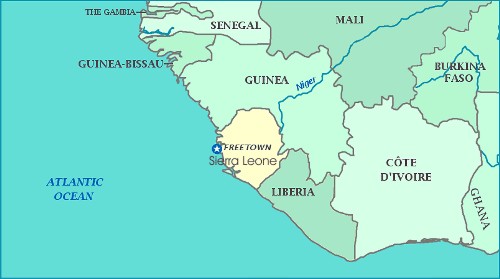 |
Jacobitism was a political movement in Great Britain and Ireland that aimed to restore the Roman Catholic Stuart King James VII of Scotland, who was also James II of England and Ireland, and his heirs to the thrones of England, Scotland and Ireland. The movement took its name from Jacobus, the Renaissance Latin form of Iacomus, the original Latin form of James. Adherents rebelled against the British government on several occasions between 1688 and 1746.
After James II was deposed in 1688 and replaced by his daughter Mary II, ruling jointly with her husband and first cousin (James's nephew) William III, the Stuarts lived in exile, occasionally attempting to regain the throne. The strongholds of Jacobitism were parts of the Scottish Highlands and the lowland north-east of Scotland, Ireland, and parts of Northern England (mostly within the counties of Northumberland and Lancashire). Significant support also existed in Wales and South-West England.
The Jacobites believed that parliamentary interference with the line of succession to the English and Scottish thrones was illegal. Catholics also hoped the Stuarts would end recusancy. In Scotland, the Jacobite cause became intertwined with the clan system. The emblem of the Jacobites is the White Cockade. White Rose Day is celebrated on 10 June, the anniversary of the birth of the Old Pretender in 1688. (A cockade is a knot of ribbons, or other circular- or oval-shaped symbol of distinctive colors which is usually worn on a hat).
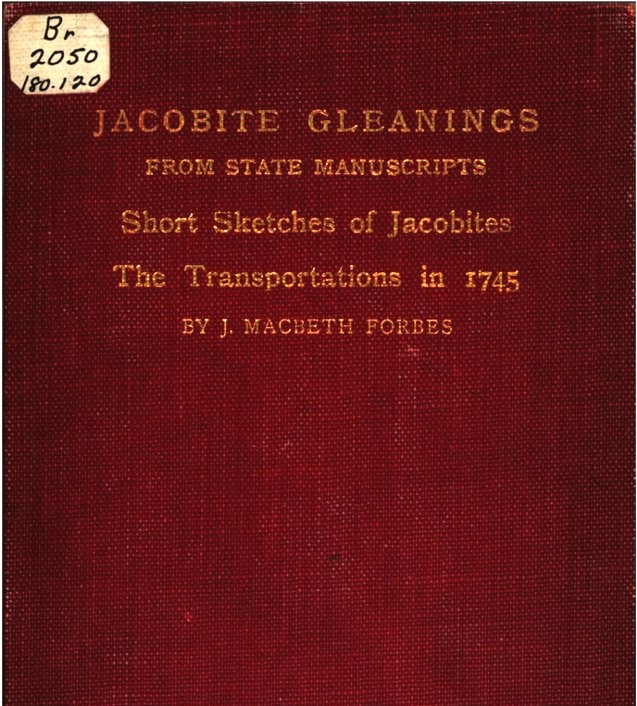 |
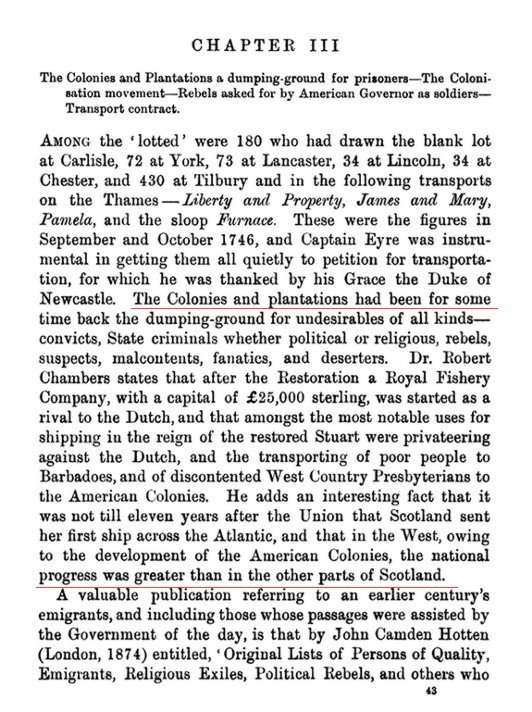 |
|
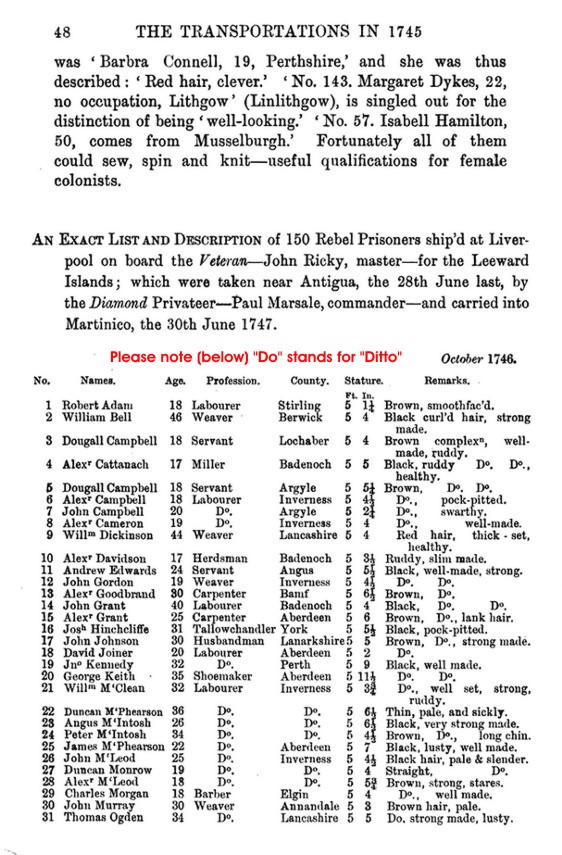 |
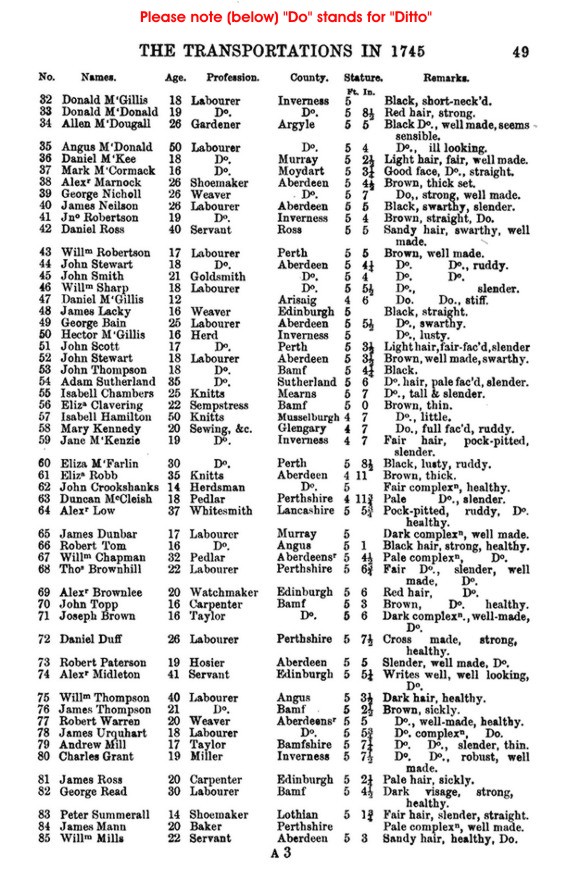 |
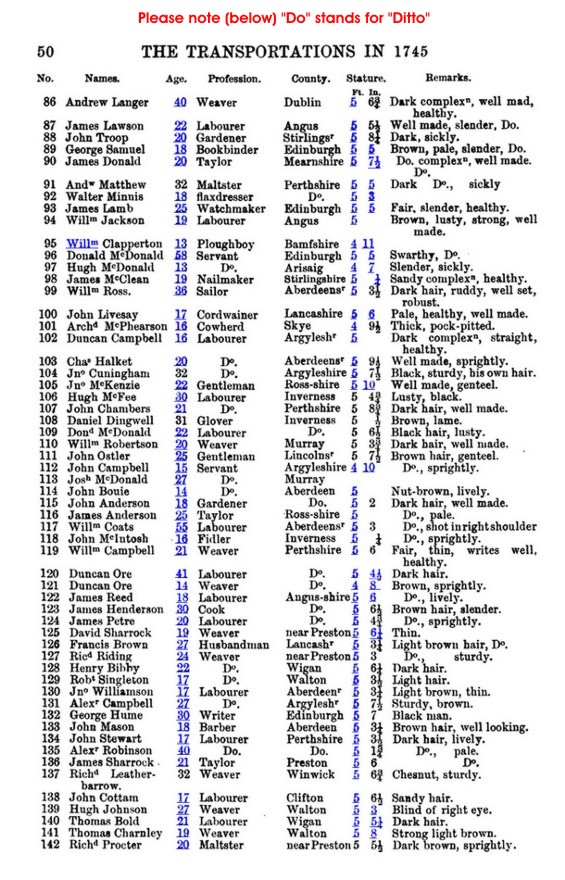 |
As we know, Red Hair is a known indicator of Albinism (whether full or partial). Note this Wiki on Red Hair: Today, red hair is most commonly found at the northern and western fringes of Europe; it is associated particularly with people in the British Isles (although Victorian era ethnographers consider the Udmurt people of the Volga to be "the most red-headed men in the world"). Redheads are common among Celtic and Germanic peoples.
In Scotland, 10% of the population have red hair and approximately 35% carry the recessive redhead gene. In Ireland, as many as 10% of the population have red, auburn, or strawberry blond hair. It is thought that up to 46% of the Irish population carry the recessive redhead gene. A 1956 study of hair color amongst British army recruits found high levels of red hair in Wales and the English Border counties.
 |
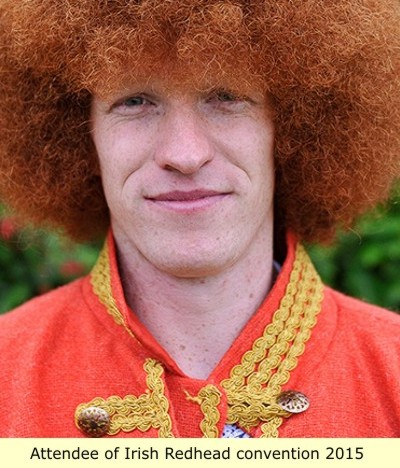 |
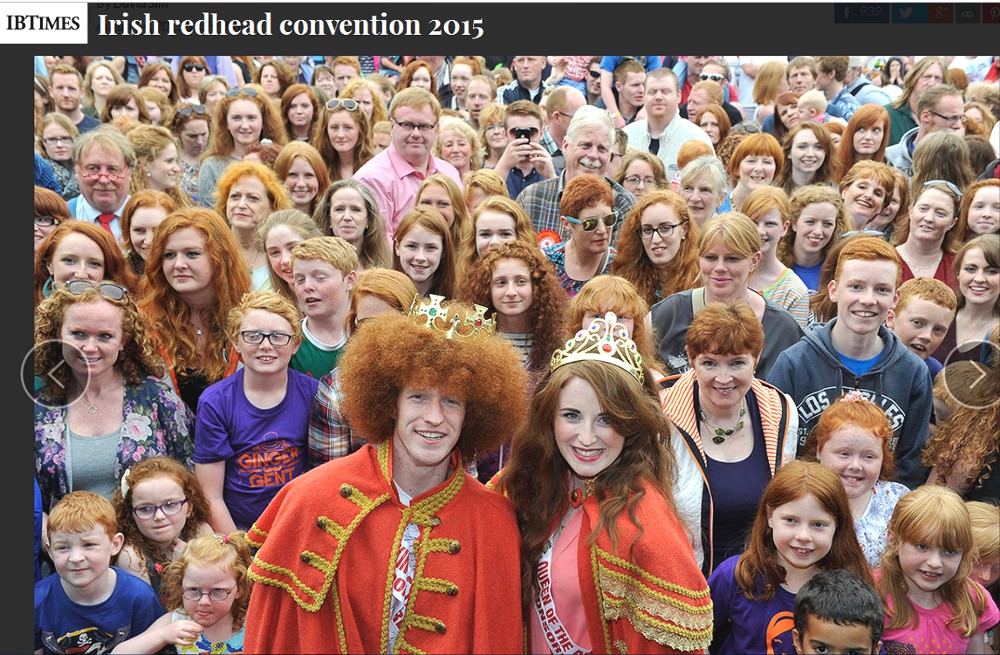 |
More about the sale of Africana.com
The New York Times -
Business Day
Co-Founders of Africana.com Sell Venture to Time Warner
By DAVID D. KIRKPATRICK
Published: September 7, 2000
Facing an uncertain climate for Internet start-ups, the founders of Africana.com Inc., the Harvard University professors Henry Louis Gates Jr. and Kwame Anthony Appiah, have sold their venture to Time Warner Inc.
Professor Gates said the deal would help keep the Web site alive. ''The revenue model was slow to develop, let's put it that way,'' he said. ''I would have become worried about its future by next year unless there was some dramatic turnaround.'' Terms of the deal were not announced.
Africana.com is one of many Web sites seeking a worldwide audience of African descent but takes a uniquely pedagogical approach. It concentrates on educational content, from cultural history lessons to advice on dental hygiene and investing, sometimes offering advice on generic subjects like health or finance from experts who are African-American. Other features, like links to music from radio stations around the world, address the ''African diaspora.'' Professor Gates and Professor Appiah started the site to promote an encyclopedia that they edited, Africana.
Professor Gates said Africana. com still records far less traffic than others in its market, like NetNoir. com, which focuses on celebrities, or BlackVoices.com, which features chat rooms. Africana.com is for-profit but does not sell banner advertisements, seeking sponsorships instead. ''We didn't want a lot of cheap ads that would dilute the brand,'' Professor Gates said.
Edward Adler, a spokesman for Time Warner, said the company hoped to use the portal to exploit its extensive library of film, television and music of interest to African-Americans. The company also envisions cooperation between Africana. com's management and its traditional media units like Time magazine and CNN, he said. When Time Warner's proposed merger with America Online Inc. is completed, Mr. Adler said, the company may include Africana.com with a version of AOL distributed free to schools.
Professor Gates said that he and Professor Appiah would continue to work on the site as ''consultants and idea people.'' The site has about 20 employees, who will continue operating it, he said.
Other partners have included the music entrepreneur Quincy Jones, the former Time Warner executive Martin Payson and Harry M. Lasker III, a computer consultant.
Henry Louis Gates Jr., co-founder of Africana.com, said it was sold
to ensure its survival. ''I would have become worried about its future
by next year unless there was some dramatic turnaround,'' he said.
(Associated Press)
General description from many books:
Maroons were runaway slaves in the West Indies, Central America, South America, and North America, who formed independent settlements together. The same designation has also become a derivation for the verb marooning. Maroon communities emerged in many places in the Caribbean (St Vincent and Dominica for example), but none were seen as such a great threat to the British as the Jamaican Maroons. A British governor signed a treaty promising the Maroons 2500 acres (10 km²) in two locations, because they presented a threat to the British. Also, some Maroons kept their freedom by agreeing to capture runaway slaves. They were paid two dollars for each slave returned. Beginning in the late 17th and early 18th centuries, Jamaican Maroons fought British colonists to a draw and eventually signed treaties in the 18th century that effectively freed them over 50 years before the abolition of the slave trade in 1807. To this day, the Jamaican Maroons are to a significant extent autonomous and separate from Jamaican society.
The Slave Trade
The English settlers concerned themselves with growing crops that
could easily be sold in England. Tobacco, indigo and cocoa soon gave
way to sugar which became the main crop for the island.
The sugar industry grew so rapidly that the 57 sugar estates in the island in 1673 grew to nearly 430 by 1739.
Enslaved Africans filled the large labour force required for the industry. The colonists were impressed with the performance and endurance of the Africans, as well as the fact that African labour was cheaper and more promising. They continued to ship Africans to the West Indies to be sold to planters who forced them to work on sugar plantations.
The slave trade became a popular and profitable venture for the colonists. In fact the transportation of slaves became such a regular affair that the journey from Africa to the West Indies became known as the ‘Middle Passage’. The voyage was so named because the journey of a British slaver was 3-sided, starting from England with trade goods, to Africa where these were exchanged for slaves. Afterwards, the journey continued to the West Indies where the slaves were landed and sugar, rum and molasses taken aboard for the final leg of the journey back to England.
The slaves, however, were unhappy with their status, so they rebelled whenever they could. Many of them were successful in running away from the plantations and joining the Maroons in the almost inaccessible mountains.
Several slave rebellions stand out in Jamaica’s history for example, the Easter Rebellion of 1760 led by Tacky; and the Christmas Rebellion of 1831 which began on the Kensington Estate in St. James, led by Sam Sharpe. He has since been named a National Hero.
The Maroons also had several wars against the English. In 1739 and 1740 after two major Maroon Wars, treaties were signed with the British. In the treaty of 1740, they were given land and rights as free men. In return they were to stop fighting and help to recapture run-away slaves. This treaty resulted in a rift among the Maroons as they did not all agree that they should return run-away slaves to the plantations.
The frequent slave rebellions in the Caribbean was one factor that led to the abolition of the slave trade and slavery. Other factors included the work of humanitarians who were concerned about the slaves’ well-being. Humanitarian groups such as the Quakers publicly protested against slavery and the slave trade. They formed an anti slavery committee which was joined by supporters such as Granville Sharp, James Ramsay, Thomas Clarkson and later on, William Wilberforce.
On January 1, 1808 the Abolition Bill was passed. Trading in African slaves was declared to be “utterly abolished, prohibited and declared to be unlawful”. Emancipation and apprenticeship came into effect in 1834 and full freedom was granted in 1838.
The immediate post slavery days were very difficult for the poorer classes. Though most of the English planters had left the islands and new owners were running the plantations, the old oligarchic system still remained. The will of the masses was not deemed important and hence ignored. To add fuel to the already burning flame, the American Civil War resulted in supplies being cut off from the island. A severe drought was also in progress and most crops were ruined.
In October 1865, an uprising in St. Thomas, called the Morant Bay Rebellion, was led by Paul Bogle. Bogle and his men stormed the Morant Bay Courthouse while it was in session. A number of white people was killed including the custos of the parish. The rebellion was put down by the Governor, Edward John Eyre. More than 430 people were executed or shot, hundreds more flogged and 1,000 dwellings destroyed.
Paul Bogle and George William Gordon, now National Heroes, were hanged. George Gordon was a prominent coloured legislator who was sympathetic to the problems of the poor people and was blamed for the trouble caused by the masses.
Eyre was subsequently recalled to England but not before exchanging the ancient Constitution for the Crown Colony system. The succeeding years saw the island’s recovery and development – social, constitutional and economic, and its evolution into a sovereign state.
English Conquest
On May 10, 1655, an English expedition, commanded by Admiral William Penn and General Robert Venables, landed at the present-day coastal town of Passage Fort, in the southeastern parish of Saint Catherine. This expedition, which had failed to capture Hispaniola, proceeded to claim the island of Jamaica for England. At the time of the English conquest, the Spaniards were unable to effectively resist the invasion because only about 500 of them were armed with weapons. The English ordered the Spanish colonists to deliver all of their slaves and goods and leave the island. Some followed these orders, but a group led by Don Cristabal Arnaldo de Isasi remained and put up guerrilla resistance to the English. Isasi freed the slaves, many of whom retreated with the Spanish rebels into the hills. From there, the Spanish and the freed blacks who had joined them frequently raided and waged guerrilla warfare on English settlements. Isasi, finally overwhelmed by English forces, fled to Cuba for reinforcement. Some of the blacks who had fought with Isasi, recognizing that the Spanish case was lost, defected to the English. A black regiment fighting for the English, led by the former slave Juan de Bolas, proved a decisive factor in the final defeat of the Spanish, marked by Isasi's retreat in 1660.
Jamaica's English-appointed governor Edward D'Oyley compensated the black regiment by officially recognizing their freedom and granting them landholdings. Other formerly Spanish-owned slaves remained autonomous of the colonial administration, living in their own communities as maroons. Spain officially ceded the island to England under the Treaty of Madrid in 1670. The English established a representative system of government, giving white settlers the power to make their own laws through an elected House of Assembly, which acted as a legislative body. The Legislative Council, whose members were appointed by the governor, served an advisory function and took part in legislative debates. This system lasted until it was replaced in 1866 by the crown colony system of government, which stripped the island elite of most of its political power.
THE SLAVE TRADE AND PLANTATION ECONOMY
The English encouraged permanent settlement through generous land grants. In 1664 Sir Thomas Modyford, a sugar plantation and slave owner in Barbados (a Caribbean island of the Lesser Antilles chain), was appointed governor of Jamaica. He brought 1,000 English settlers and black slaves with him from Barbados. Modyford immediately encouraged plantation agriculture, especially the cultivation of cacao and sugarcane. By the early 1700s sugar estates worked by black slaves were established throughout the island, and sugar and its by-products dominated the economy. Other economic activities, including livestock rearing and the cultivation of coffee and pimento (allspice), developed as well.
With the establishment of the plantation system, the slave trade grew. Slaves of both genders and every age were found in all facets of the island's economy, in both rural and urban areas. They were laborers on plantations, domestic servants, and skilled artisans (tradesmen, technicians, and itinerant traders). The wealth created in Jamaica by the labor of black slaves has been estimated at £18,000,000, more than half of the estimated total of £30,000,000 for the entire British West Indies. It has been postulated that the profit generated by the 'triangular trade' (involving sugar and tropical produce from the British Caribbean colonies, the trade in manufactured goods for slaves in Africa, and the trade of slaves in the British Caribbean) financed the Industrial Revolution in Britain.
More than 1 million slaves are estimated to have been transported directly from Africa to Jamaica during the period of slavery; of these, 200,000 were reexported to other places in the Americas. During the 17th and 18th centuries, the Akan, Ga, and Adangbe from the northwestern coastal region known as the Gold Coast (around modern Ghana) dominated the slave trade to the island. Not until 1776 did slaves imported from other parts of Africa-Igbos from the Bight of Biafra (southern modern Nigeria) and Kongos from Central Africa-outnumber slaves from the Gold Coast. But slaves from these regions represented 46 percent of the total number of slaves. The demand for slaves required about 10,000 to be imported annually. Thus slaves born in Africa far outnumbered those who were born in Jamaica; on average they constituted more than 80 percent of the slave population until Britain abolished the slave trade in 1807. When Britain abolished the institution of slavery in 1834, Jamaica had a population of more than 311,000 slaves and only about 16,700 whites.
By the mid-1700s planters were distributing small plots of marginal land to their slaves, both men and women, as a way to offset the cost of providing food. However, the slaves were expected to tend their own crops only during their limited free time. Although slaves were not allotted much time to work the plots, they were able to produce enough not only for their own subsistence but also for sale. A vibrant marketing network developed among the slaves throughout the island, creating what is referred to as a proto-peasantry.
In the British mind, slaves were no more than property and merchandise to be bought and sold. On this premise, the British enacted a whole system of slave laws aimed primarily at policing slaves. In general, the premise that slaves were no more than property allowed slave owners to treat them brutally. The severity of this brutality varied. Slaves on large sugar estates generally suffered the harshest punishments, while those on smaller estates and in towns received somewhat better treatment.
FREE COLOURED COMMUNITY
White men on the island often had relations with black women (slaves or free), giving rise to a coloured population. ('Coloured' is a term in the former British colonies for people of mixed European and African descent.) Children of free women were born free, but those of slave women were born enslaved. Some coloureds who were born as slaves were freed through manumission (the formal release of a slave) by their fathers. Masters at times also manumitted black slaves for various reasons, such as in reward for a lifetime of servitude. Free coloureds formed a middle group on the social ladder, between blacks and whites. They disassociated themselves from the slaves but were not accepted by the whites. The number of free people of color (including free blacks and free coloureds) increased significantly between 1722 and 1830, from 800 individuals to 44,000. Free coloureds were principally urban dwellers, participating in several phases of economic life. They were artisans, merchants, mechanics, and professionals-lawyers, schoolteachers, and journalists. A few inherited plantations from their fathers. Free coloured women excelled as traders, shopkeepers, innkeepers, and housekeepers. Many free coloureds were well educated, as education was valued as the vehicle for upward social mobility and 'acceptance' by whites. Many coloureds attended universities in Britain, and their children outnumbered whites at the Wolmers Free School in Kingston, which was established for the white population in the 1700s. In 1837 there were 430 children of free coloureds attending this school, out of a student body of 500.
Despite their numbers and the education and wealth some obtained, free coloureds had no civil rights. Therefore they were caught up in a continuous struggle for equal rights. They protested primarily through petitions and memorials rather than open violent conflicts. In 1813 a petition, signed by more than 2,400 free coloureds, demanding rights to give evidence in court was delivered to the House of Assembly, which acceded. In 1816 free coloureds petitioned for full political and civil rights on the grounds that they were taxpayers but were not represented. They threatened to cease paying taxes until they were granted these rights. Under pressure from free coloureds, the local authorities gradually removed legal restrictions, culminating on December 21, 1830, with the Act for the Removal of All Disabilities of Persons of Free Condition.
MAROON COMMUNITIES
Since their arrival on the island, blacks had resisted their enslavement. They engaged in what is referred to as atomized forms of resistance, such as foot dragging (work slowdowns, or 'go-slows'), destruction of property, theft, absenteeism from work, and the covert murder of whites. But resistance also took the forms of large-scale rebellions and establishment of maroon communities.
Maroonage, or the establishment of communities by runaway slaves, began with the slaves imported by Spain and continued throughout the period of slavery in Jamaica. The maroon communities waged relentless warfare against British colonialism. Beginning in the 18th century, two distinct groups of maroon communities emerged: the so-called Leeward Maroons in the south central, or leeward, part of the island and the so-called Windward Maroons in the north and northeast. The Leeward Maroons had an elected chief, and the villagers were divided into politico-military units. Their system was stratified based on ability, especially military ability, and a careful division of labor. Some were proficient in attacking plantations to steal provisions and free slaves, especially female slaves because men outnumbered women in the maroon communities. Others were hunters, hunting wild hogs; others made salt, necessary for meat preservation; and others cleared the ground for the women to plant crops, such as plantains, sweet corn, bananas, cacao, pineapples, cassava, and sugarcane.
The Windward Maroons did not have a central leader as did the Leeward. They developed a somewhat loose federation of communities or quasi-autonomous villages under different leadership, having a politico-military structure that made for democratic inter- and intra-group relationships. Nanny Town (named after its legendary leader, Nanny; now known as Mooretown), which was situated deep in the Blue Mountains, was reputed to have the greatest warriors among the Windward Maroons, numbering 300 in their ranks. Both the Leeward chief, Cudjoe, and Nanny were notorious for their continued and relentless attack on British colonization and slavery. Nanny fought uncompromisingly against slavery. In addition to being a feared warrior, she was said to be an obeah woman, possessing supernatural powers that she allegedly used in repelling and defeating British attacks.
For reasons of security, maroon villages were located in the relatively inaccessible mountains, giving them a commanding view of the lowlands. Guards were posted at the entrance to watch and alert communities at the approach of the British by blowing the abeng, the conch shell or cow horn, as was the practice in parts of West Africa.
The boldness of the maroons, their prowess in guerrilla warfare, and their knowledge of the terrain made them a serious threat to English colonization, the plantation economy, and slavery itself. They plundered and burned plantations, captured slaves, took arms and ammunition, and killed English soldiers who ventured into the interior. Their continued successes against English forces inspired slaves, many of whom escaped the plantations to join maroon communities or to establish new ones. The maroons were such a formidable force that the English were unable to subjugate them after 85 years of intense, bitter struggle. The English conceded defeat in 1739, ending the First Maroon War. In the peace treaties, the maroons won their independence and freedom. They were granted semiautonomous government status and land in return for halting all hostilities against whites, obligating themselves to assist in case of foreign invasion, destroying any new maroon communities, and capturing and returning future runaways. Thus, on the fringes of the slave-plantation economy established by Europeans, semiautonomous communities of free blacks developed, with their own economy and culture partially based on African traditions.
An uneasy peace prevailed until July 1795, when 580 maroons from the maroon community of Trelawny Town revolted against indignities and injustice meted out to them by the authorities. It took considerable force to suppress the revolt, known as the Second Maroon War. The British forces consisted of 1,500 soldiers supported by several thousand militiamen and 100 fierce bloodhounds imported from Cuba in December of that year. In June 1796 the government deported 568 maroons (including men, women, and children) from Trelawny Town and confiscated their land. They sent the maroons first to Nova Scotia, in what later became Canada, and subsequently to Sierra Leone. This deportation effectively deterred further maroon hostilities. Fearing deportation, they collaborated fully with the authorities, especially in suppressing slave revolts. The action of the maroons in suppressing the Morant Bay Rebellion in 1865 testifies to their full cooperation with the government. The treaties successfully reduced maroonage and the formation of new maroon communities, but some of the maroon communities that were already established have survived to this day. The surviving maroon communities are Nanny Town; Scott's Hall in the present-day northern parish of Saint Mary; and Accompong (named for Cudjoe's brother, who had distinguished himself as a military leader with the Windward Maroons) in the southwestern parish of Saint Elizabeth. However, the retention of African cultural and political practices within these communities varies.
SLAVE REVOLTS
Ethnicity was prominent in the organization and execution of slave revolts in Jamaica, especially those during the 17th and 18th centuries. Akan slaves were involved in most revolts. In 1673 about 300 Akan slaves revolted in the north central parish of Saint Ann. In 1690 another Akan rebellion involving 400 slaves broke out on Suttons Estate in the south central parish of Clarendon. After setting the plantation on fire the rebels fled to the hilly interior, from where they conducted continuous raids on nearby plantations. In 1745 Akan slaves revolted in the southeastern parish of Saint Thomas.
In 1760 a slave by the name of Tacky, an Akan who had been a chief in Africa, led the most widespread slave revolt in Jamaica's history. Beginning in the northeastern parish of Saint Mary, it soon spread to a number of parishes, including Westmoreland, Saint James, and Clarendon, and to the capital of Kingston. The rebels, inspired by the victory of the maroons in winning their liberty, fought in the same manner in an effort to win their freedom. It took the authorities six months to suppress Tacky's revolt, and by then the rebels had killed 60 whites. Tacky was shot dead by a maroon, and the authorities executed nearly 400 slaves. Other revolts broke out in 1761, 1765, and 1766, but they were quickly crushed by the authorities with the aid of maroons.
The most violent slave revolt of the 19th century was the Baptist
War, also known as the Christmas Rebellion, in 1831. Led by Samuel
Sharpe, a Baptist deacon and domestic slave, the revolt began in Saint
James and soon engulfed much of western Jamaica. In its suppression,
more than 430 blacks, including Sharpe, were executed. All who were
thought to have been associated with the revolt, including white
missionaries, were either imprisoned or killed. This revolt was a
decisive factor in the British move toward emancipation, in addition to
intensified antislavery agitation by the Quakers (Society of Friends)
in Britain, led by Thomas Buxton, Thomas Clarkson, William Wilberforce,
and Stephen Lushington.
APPRENTICESHIP AND EMANCIPATION
Full emancipation was a gradual process in the British colonies. The first step occurred with an 1833 legislative act of the British Parliament that proposed a program known as apprenticeship. The act became effective in all the British colonies on August 1, 1834. All slaves' children under the age of six or born after this date were freed, while all others were required to undergo a transitional period as 'apprentices' before full emancipation. The act sought to soften the effects of abolition on slave owners by giving them monetary compensation of £6,161,927 for their loss of property in slaves. The slaves received no compensation.
Thomas Peters
In November of 1776, Thomas Peters joined an all black regiment called the Black Pioneers. Prior to joining the regiment, he was a fugitive slave who left Wilmington, North Carolina. While serving with the Black Pioneers, Peters became well known and progressed to the rank of sergeant. But when the British and their Loyalist allies began to make plans to evacuate in 1782, the Black Americans were the last to be provided for. The Black Pioneers along with about 5,000 others were transported from New York to Nova Scotia. The other refugees scattered across the Atlantic world, profoundly affecting the development of Nova Scotia, the Bahamas, and the African nation of Sierra Leone.
When Peters arrived in Nova Scotia, he became a resident of Brindley a town near Digby. He received rations from the government for a time, but decided to leave Annapolis County for Saint John because he could not secure farmland near his town lot. He relocated to Saint John; unfortunately, the settlement situation was much the same there. Blacks had received only one acre each, many blacks in both Nova Scotia and New Brunswick had a lot of trouble being granted farms. Thomas Peters became their representative and drafted many petitions for them. When they were rejected he decided to travel to England to represent them to the Crown.
In 1790, Thomas Powers carried a petition of protest to London from the Nova Scotia black Loyalists. The British government responded by offering free passage to Sierra Leone to blacks who wanted to leave Canada. Peters' story attracted the attention of the Sierra Leone Company through Granville Sharp a famed abolitionist and philanthropist. The company was working to establish a settlement in Sierra Leone, but badly needed new settlers to rebuild the destroyed settlement. The company offered Peters and his followers a new promised land in the 'Province of Freedom'.
Peters was excited to have a new, more promising settlement opportunity. He reported the news to the blacks he represented and was appointed as an intermediary between the Sierra Leone Company and his people. Peters was influential in many people's decision to go to Sierra Leone and worked closely with John Clarkson the Superintendent, to prepare for the voyage. With few options other than working as servants or tenant farmers, some 1,200 decided to make the journey in 1792. Entire church congregations emigrated, providing a strong institutional basis for the struggling African settlement. In Sierra Leone, Nova Scotians became known as the "Krio".
After Peters arrived in Sierra Leone he found that there were still many problems. The blacks had not received their land grants as soon as expected. In addition, Clarkson was not well and could not hear all of the people's complaints. Peters protested the lies and exaggerations made to his people such as the promises of no land taxes, land grants withing weeks, and a democratic government. Some of his group of Methodists not only agreed with him, but also wanted him to be the governor of the colony. They decided to have him represent their cause to Superintendent Clarkson.
Clarkson did not look upon Peters petition favorably and felt it was an attack on his authority. He confronted Peters publicly and most of the colony sided with Clarkson. Peters lost much of his influence with the blacks of Sierra Leone. Shortly afterwards, Peters was accused of theft from a dead man. When brought before the courts, Peters explained that he simply collecting a debt for having helped the man escape from slavery. A jury of his fellow blacks didn't think much of this explanation, and convicted him. Soon after Peters grew sick and died; a humbling end to a glorious life. The Sierra Leone Company still refused to allow the settlers to take freehold of the land. Some of the Settlers revolted in 1799. The revolt was only put down by the arrival of over 500 Jamaican Maroons, who also arrived via Nova Scotia. The “Nova Scotians” quickly came to dominate life in Sierra Leone, which was largely self-governing until 1801.
According to Jewish scholar Dr. Harold Brackman, during the 1600s “slave trading in Brazil became a ‘Jewish' mercantile specialty in much the same way it had been in early medieval Europe.” In fact, wrote Jewish scholar Jonathan Schorsch, “Jewish merchants routinely possessed enormous numbers of slaves temporarily before selling them off.” If a slave auction fell on a Jewish holiday it was postponed due to lack of buyers and sellers!
The Jewish Encyclopedia adds that “Jewish commercial activity” in this time included a “monopoly of the slave trade.” Jewish traders bought Africans in lots from the Trans-Atlantic shippers and retailed them to inland plantation owners.
The Jews of Surinam gave their slave plantations Hebrew names such as Machanayim, Nachamu, and Goshen. According to Dr. Marcus Arkin, they used “many thousands” of Black slaves. Rabbi Herbert I. Bloom added that the “slave trade was one of the most important Jewish activities ...” In 1694, Jews owned 9,000 Africans, and by 1791 there were 100 “Jewish mulattoes” in Surinam—the result of the rape of African women by their Jewish enslavers.
The prominent Jewish historian Dr. Cecil Roth wrote that the slave revolts in parts of South America “were largely directed against [Jews], as being the greatest slave-holders of the region.” Jews set up militias with the sole purpose of fighting the Black Maroons, the escaped Africans who were fighting to free their enslaved brethren.
The first Hebrew poem written in the New World was an attack on the Black Maroon leader. The Jewish militias murdered the Maroons and cut off their hands to award as trophies.
The Dutch captured the British colony of Suriname (formerly Dutch Guiana) during the Second Anglo-Dutch War(1667), and under the WIC it was developed as a plantation slave society. It was a primary destination for the Dutch slave trade, yet unusually it never experienced a general slave rebellion. The regime was one of extreme and deliberate brutality, even by the standards of the time. Mortality was so high that although 300,000 slaves were imported between 1668 and 1823, the ravaged population was never able to grow beyond a figure of 50,000. 'Maroonage' emerged as the main method of resistence.
As most of the land was given to the production of sugar cane, The Dutch relied on African slaves. As the country is mostly rain forest, escape was not difficult. Many Africans escaped virtually off the boat. With the help of the native populations they were able to create their own villages and form independent ‘tribes’. Among the various African tribes in Suriname are the Saramaka, Paramaka, Ndyuka, Kwinti, Aluka and Matawai. These ‘Maroons’ as they were called by the Spanish, raided plantations, freed more slaves, and killed many planters.
Unable to militarily defeat them, the Dutch formed treaties which gave the Maroons sovereign status over the land they occupied and various trading rights. In 1760 the Treaty of Ouca guaranteed the autonomy of these Maroons. They were the first peoples of the Americas to gain independence from colonial control. Slavery was officially abolished in 1863 but it wasn’t until 1873 the slaves were released after a ten year transition period. As soon as they gained their freedom, the ex-slaves left the plantation for the city of Paramaribo. The various tribes continue to live in Suriname as they have for hundreds of years.
The Scottish-Dutch soldier John Gabriel Stedman witnessed the oppression of the slaves during a campaign against the maroons in 1774. His book a Narrative of a Five Years Expedition Against the Revolted Negroes of Surinam, with vivid illustrations by William Blake and Francesco Bartolozzi was taken to heart by abolitionists.
 |
| Click for Realhistoryww Home Page |